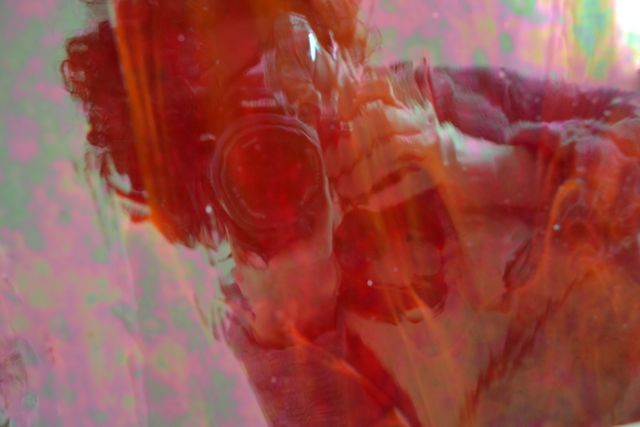
Behind the Glass :
the inner world of mosaic artists
We live in a time of art and craft revival, where people are re-discovering the joy of making and the connection between creative expression and well-being. Running quietly alongside this welcome trend is a long history of art as therapy, both in the clinical sense and in the radical edges of the Outsider Art movement. From the suicidal intent in the poems of Sylvia Plath to the joyful paintings of Agnes Martin, creative expression has long been considered as linked to both mental well-being and mental suffering (Jamison, 2011).
Whilst this idea is generalisable across all forms of creative expression, there is a strong sense in the mosaic-making community that our beloved medium is unique in its ability to facilitate an intimate relationship between the maker and their inner experience – be that one of well-being, distress or recovery from life’s adversities. Some would argue that the practice of mosaic creates a direct and deeply attentive link between hand, head and heart during the making process (Severini 1952, Sizemore 2012).
Many mosaic makers, both amateur and professional, work from a sense of intuitive knowing that the act of mosaic-making is intrinsically linked to their emotional and mental well-being.
However, the relationship between mosaic making and mental health is not necessarily linear or one-way. Is our mental health (or ill health) the source of our creative expression or is our creative expression a way of maintaining or influencing our mental health? Or both?
Sometimes this relationship is obvious. At other times the relationship is more hidden, as if looking through an opaque glass. This is when the urge to create and the compulsive act of making – of ‘going with the flow’ of the mosaic (Csikszentmihalyi, 1990) takes on a life of its own. Indeed, many talk of the mosaic itself taking on a life of its own, much like the characters in a book at the hand of a passionate author. Suddenly, the implicit movements of the mind and heart come out from behind the glass.
The catalyst for convening this online exhibition was my participation in the King’s College London Interdisciplinary Award, ‘A Beautiful Mind’ which examines the intersection of art, science and mental health. It is this link between mosaic-making and the mental states of the maker – be that of well-ness, illness or recovery – that is the exploration of this exhibition.
What we see emerge is the strength of mosaic making as a way of calming inner turbulence, regulating a busy nervous system and ‘grounding’ when faced with strong emotions – the mosaic making taking on an mindful quality (Rappaport, 2014). Making mosaic brings together fragmented parts of self, a strong metaphor of the medium. It also serves as a way to process illness and bereavement, the end product of which is a lasting tribute to inner experiences and to loved ones. Lastly, this most solid and tangible of art forms is used to outwardly express an inner desire for connectedness – to different parts of self, to others, to creativity and play and to the earth itself.
“Art is a wound turned into light.”
Georges Braque
ENJOY!
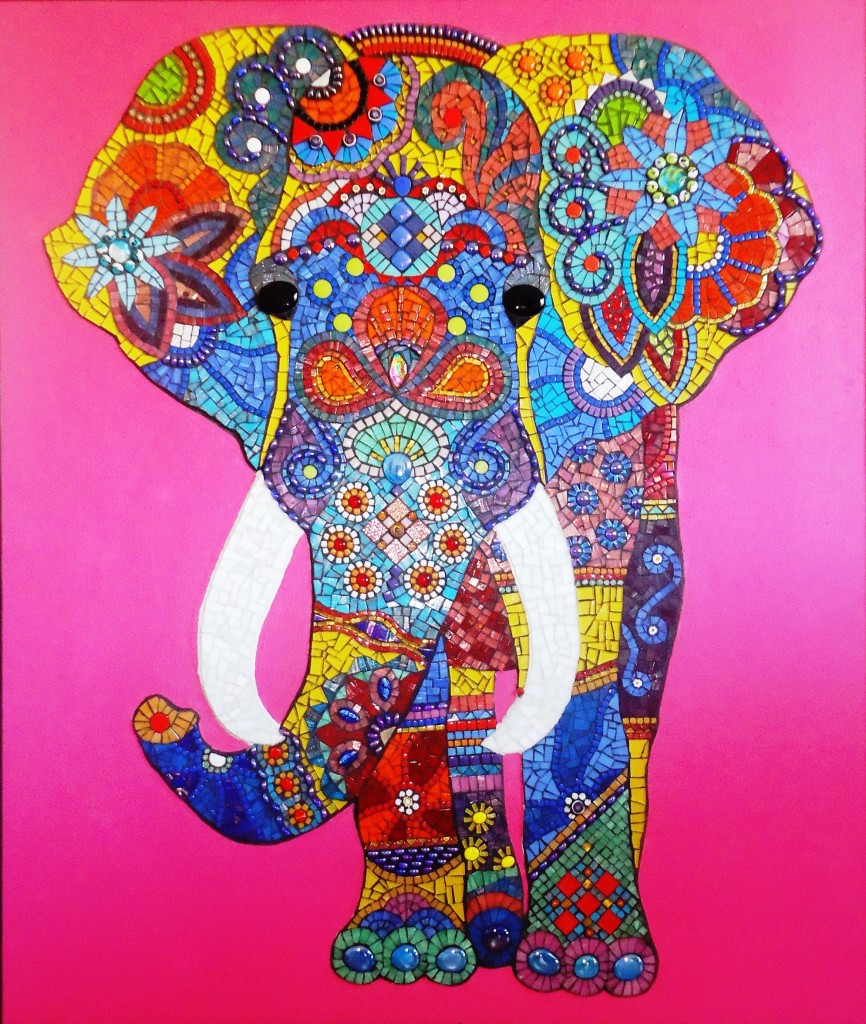
‘Elephant’ by Julee Latimer, Australia. www.juleelatimermosaics.com
Elephant materialized at a pivotal point in my art career. Disillusioned with mosaic and on the slippery slope of sculptural frustration, I determined to create a flat piece to use up tesserae and gems that I had limited supply of. I made the monumental decision that this would be my final mosaic. I worked completely spontaneously as always, with no real regard to how the patterns and colour would interact. Yet as I progressed I was drawn further in, returning to that place which always inspires me, that of childlike curiosity and fun. I realized that despite my stresses, deep down I was still ultimately very happy. This was a truly cathartic moment as I understood that the journey into the magic of creation was actually the goal and not the means. I am currently still making mosaic.
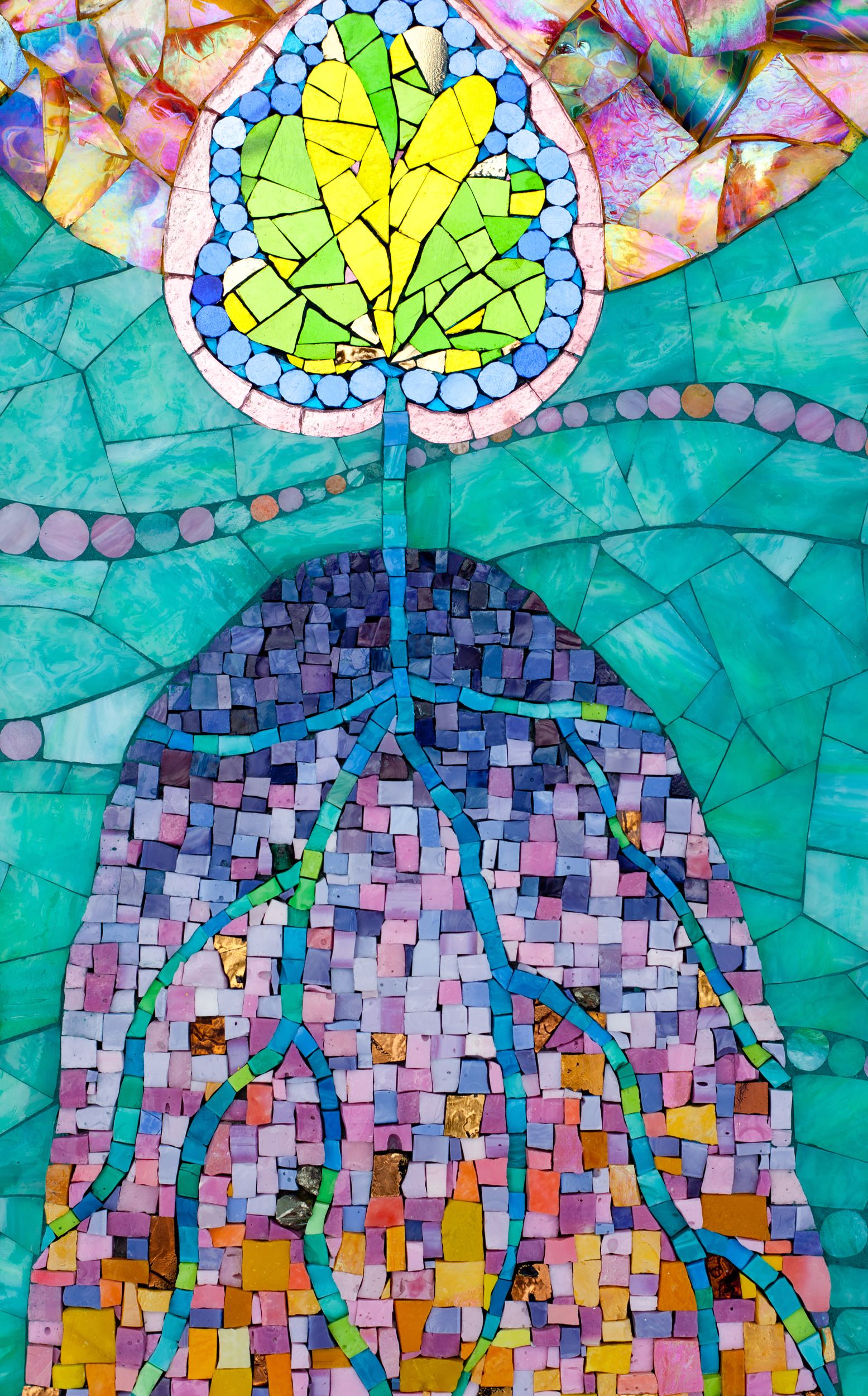
‘My Life as a Hill’ by Pamela Goode, USA. http://www.pamelagoodemosaics.
As artists, we tend to be either captives or refugees of our inner worlds. I spend a great deal of time there by choice, both for my own evolution and as fodder for the work I produce. Much of my strength comes through the meticulous cutting and fitting of small, hard objects. There’s something about working for your joy, wrestling for your joy, that makes mosaic art intensely fulfilling at a visceral level, serving as a how-to lesson for facing each day. My Life as a Hill reflects similarities between the human body’s composition and that of the earth’s own elements. Always aware of the frailty of life, this is of great comfort to me. It means that I’m part of the universe in many more ways than I’m aware, whole and elemental, nourishing and stalwart, capricious and volatile — and it’s all very okay. We nourish the best parts of ourselves, we reach for the sun, and we grow.
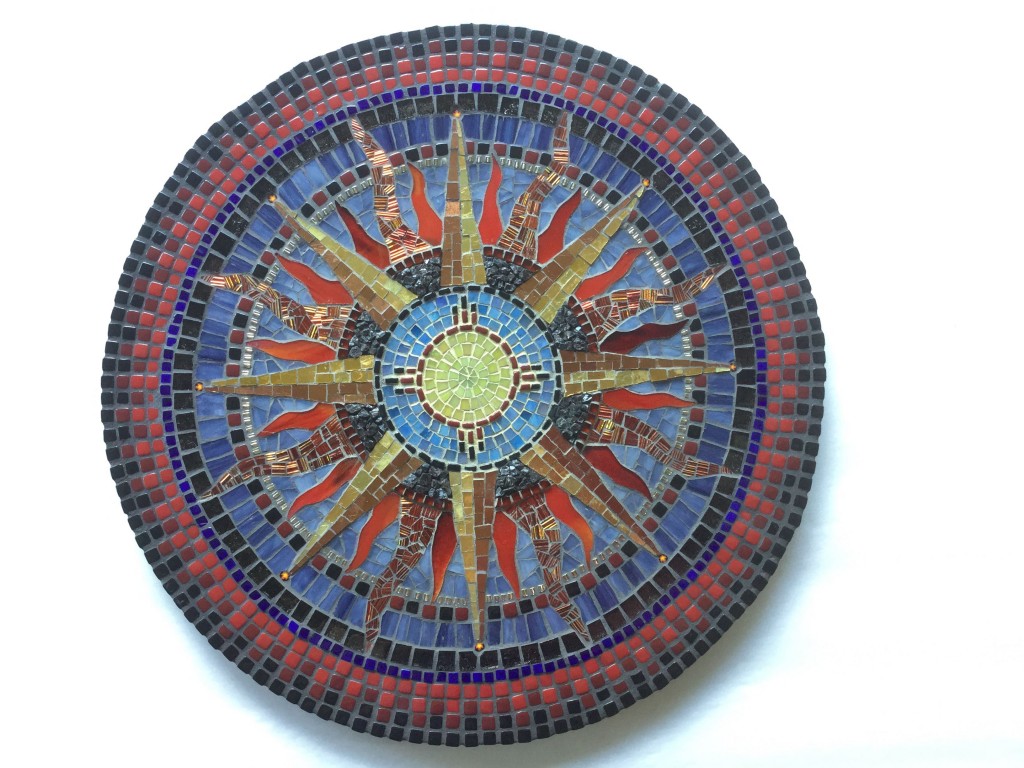
‘The Same Sun’ by Dianne Sonnenberg, USA. http://DianneSonnenberg.com
I have recently located my biological family, after a lifetime of feeling a strong connection to people I did not know. I grew up in a family I did not belong to, and the joy of finding my true family has been overwhelming. This mosaic represents my reconnection. The central sun signifies my indigenous heritage. The warm glow of the 24K gold directional spires reach out toward the edges of my world. The “embers” of black granite yield to fiery rays of dichroic glass, conveying a strong positive energy that I now feel whenever I think of my family. Mixed emotions cloud my feelings, as I live over 1500 miles away from the people I have longed to know, and now love very deeply. Words from my brother inspired the title for this piece. “Though we may be separated by distance, when we look up, we see the same sun.
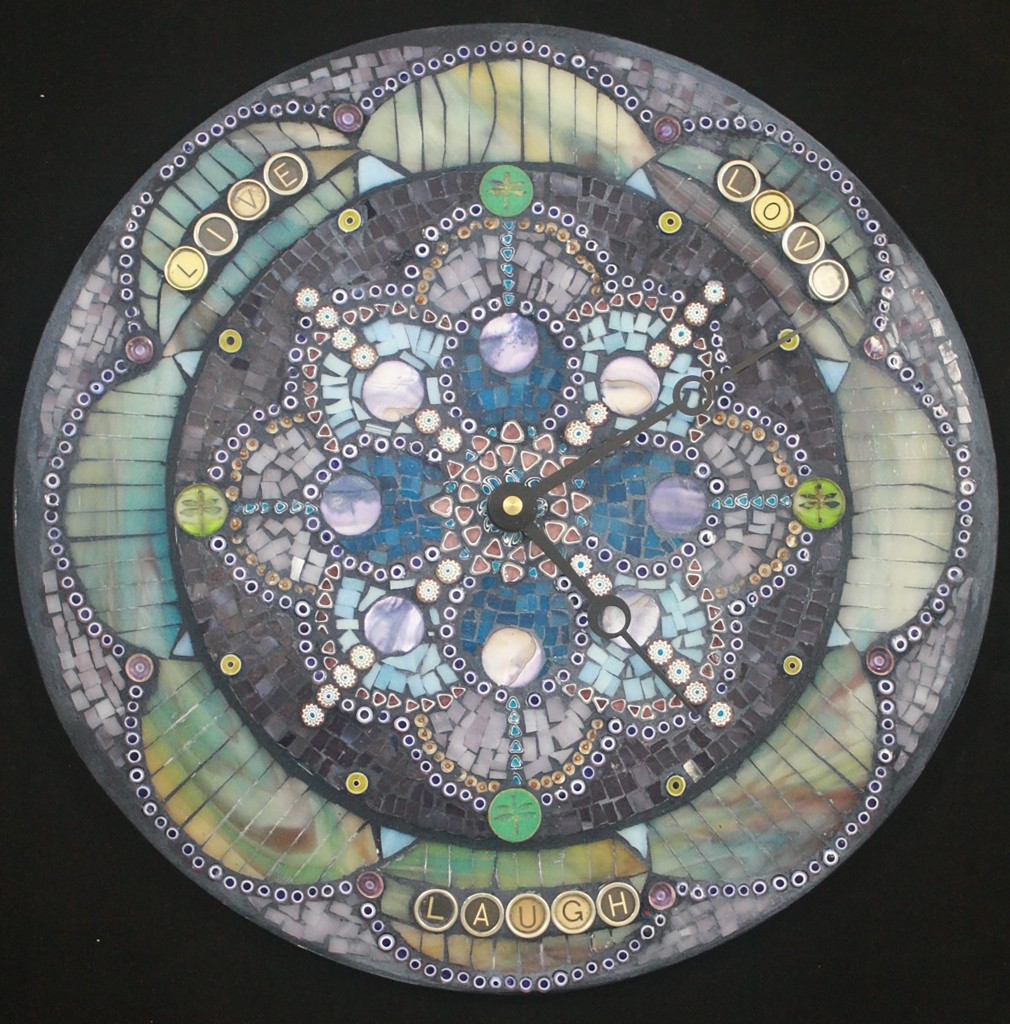 Caitlin & Elijah’ by Penny Toomim, USA.
Caitlin & Elijah’ by Penny Toomim, USA.
My piece is a clock I made for my daughter as a wedding gift.
The requirements for this piece were made by myself and my daughter. It was to say “live, laugh, love”, a family motto and the colors needed to be blues and purples. The color combination is not one I usually use and I was struggling to make it work. I asked what accent color I could use, I was told tan. That really through me for a loop. Then I found the piece of glass which has, blues, purples, and brown swirls. It was through that piece of glass that this piece flowed from. I did not have a pattern. It was the glass that set the mood and placement for this piece.
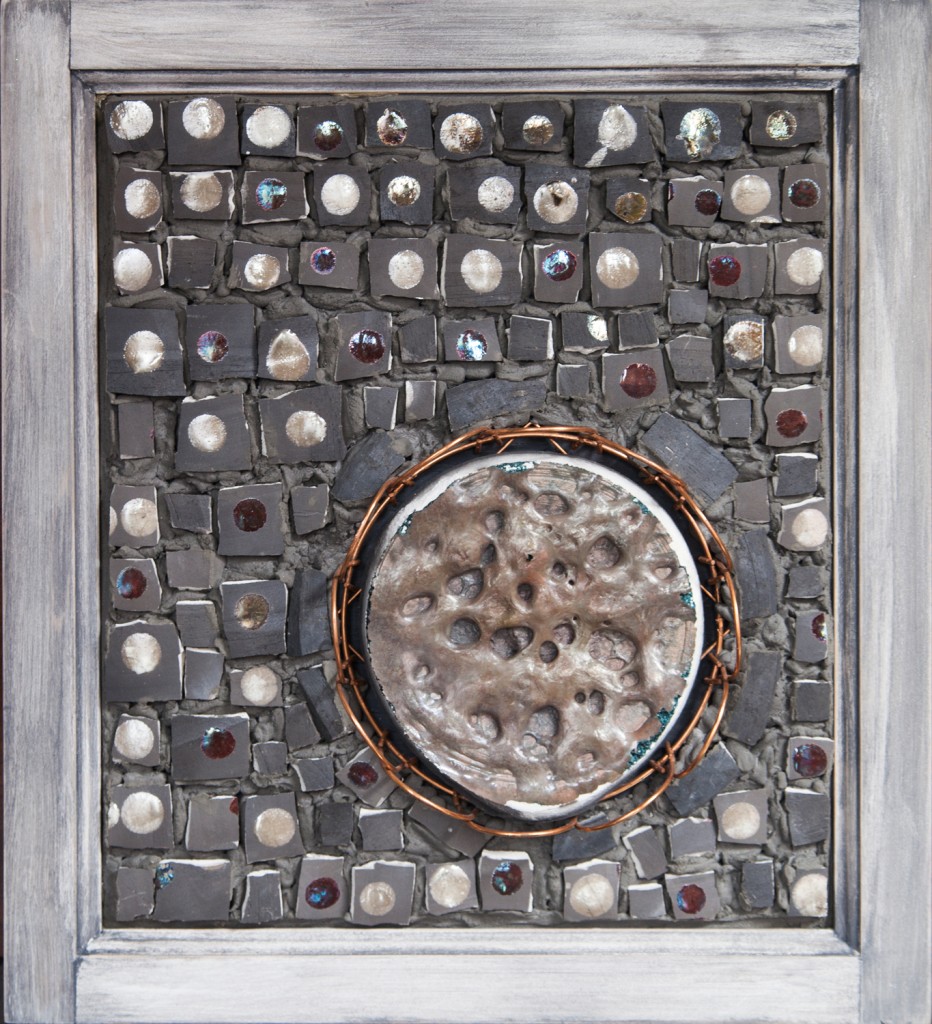
‘Limited Capacity’ by Heather Vollans, Canada www.dawningdecorstudio.com
I witness every day the impact art-making has on people. In the classroom, in hospitals, nursing homes – many places where the process of making personal art has impacted the life journey of the doer. Process is everything …the materials, the design, the doubt, the experimenting, the placement, the struggle, the finessing …all play a part in the emotional journey. My piece began with a colour called Copper Mine. Curious about how I could interpret the colour I began researching copper mines. What impacted me most was the detrimental health effects of mining, and what it does to the environment. I became obsessed, delving further and further. The more I delve, the more there is to know and the more I want to speak to in my work. This first artwork has turned into a series. My journey has led me to people who have been affected by mining. My thinking has shifted from curiosity to passion to obsession. The journey has just begun.
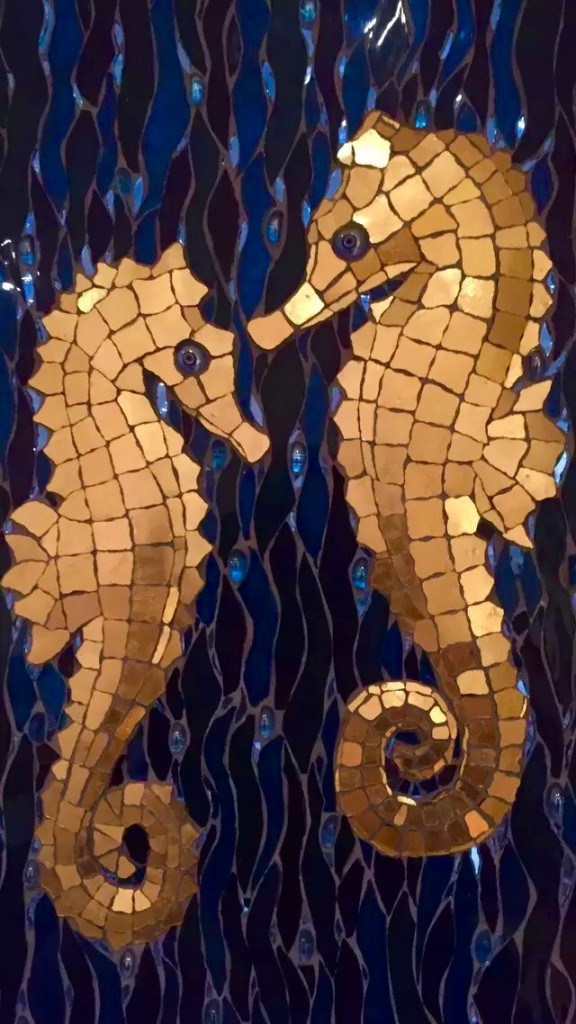
‘Shimmering depths’ by Surabhi Taori, UK.
I work in healthcare, where pain, anger, fear and distress are the daily deal, starting with patients but invading into those who look after them. The discovery of mosaic started with a desire to decorate my backyard, and soon progressed towards its unlimited potential for self-expression. As a philosophy it fits in perfectly with my personality: creating something beautiful using disjointed, incomplete, broken pieces. While absorbed in a project, performing this slow yet magical transformation, the experience is almost like deep meditation. The involvement of the tactile senses in a calm, rhythmic yet active and energetic way purges my negative emotions and allows reconnection with my deeper self to discover again the calm that was always there but forgotten and neglected in the storm of the day. The beauty of this practice is such, that even when not actively mosaicking, the memory of the peaceful experience can be recalled at will to perpetuate into any unpleasantness at hand.
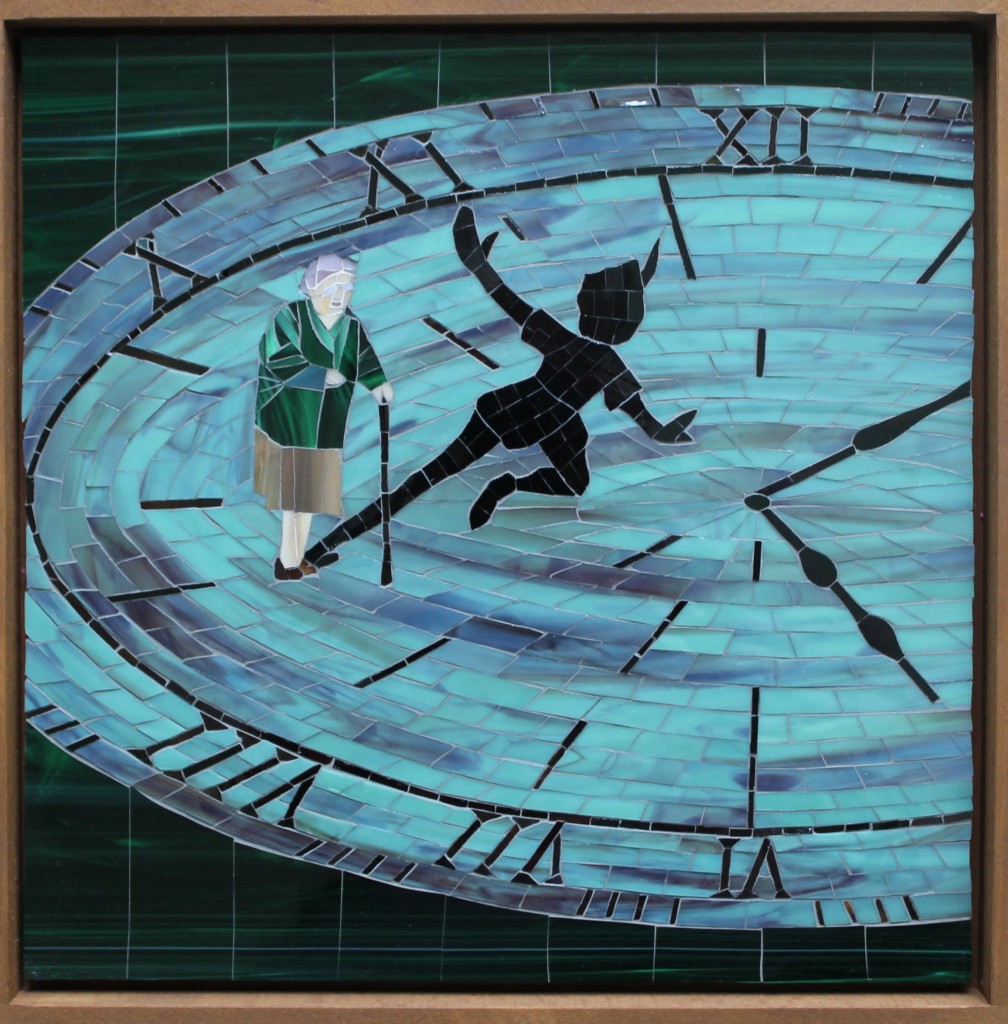
‘Knowing’ by Rhonda Doenges., Germany. www.rdmosaik.de
Usually, when I think about a new design, I start with color and material. From there it slowly develops and I move forward with a first rough sketch. In its development from elusive to concrete the mosaic is always on my mind and it begins to connect to my inner self more and more. During this process it is not always obvious to me how my sub conscious shapes the flow of my work because I am so focused on mastering my technique, but after completing the work I always come to realize the influence of my emotional state of mind. My work “Knowing” has become very personal in a difficult path of my life. Creating and bringing something to the surface which would otherwise be caught inside, fills me with great happiness and is important for my mental well-being.
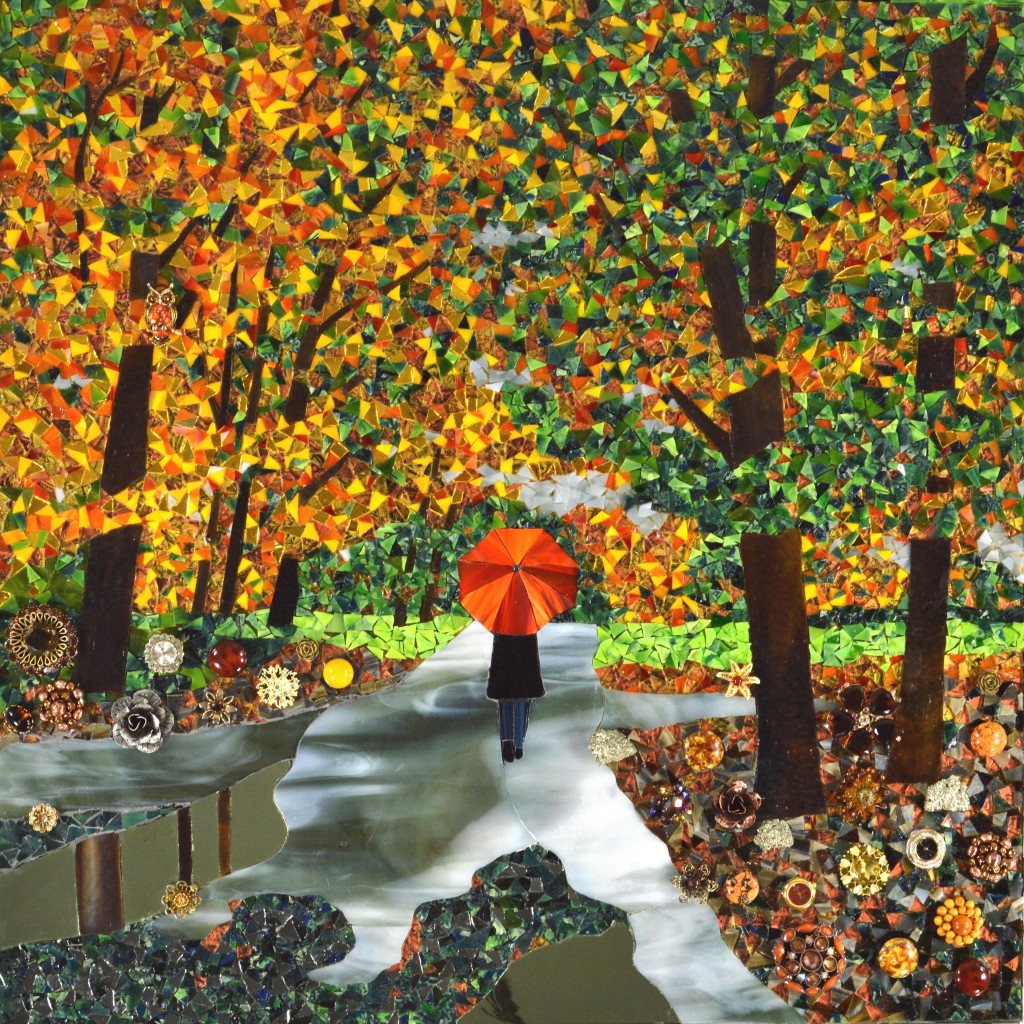
‘Only a few moments in time’ by Patty Van Dolson, USA. http://shardsofreflection.com/
I use mosaic art to explore the hope, loneliness, and imminence of mortality in a journey with stage 4 breast cancer. Sometimes my work reflects the sheer joy, beauty, and color of life; other times it reflects contemplation, or snarky gallows humor. The title of this piece refers to how ephemeral life is, and how each of us in the scope of things truly only has but a few moments in time. Color symbolism is used to suggest the fleeting transition from life (green leaves) to death (autumn/fall leaves). Small watch faces in the foliage (set to the eleventh hour) symbolically reflect that time ticks for us all, and a hovering owl symbolizes death. Life is a journey, and every path has its puddles.
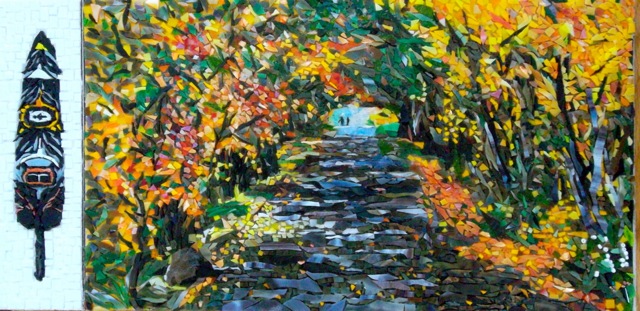
My mother became ill when I was a tender 8 years old,and I was sent to live with my Ojibwe great-grandmother from Naubinway, MI. In her wisdom, she helped me overcome my bruised spirit and separation from my family, by teaching me mosaic art. On my first evening there, I heard dishes breaking and thought surely she was angry for having to care for a young child. With a TV table and a bucket full of broken pieces, she helped me create my first mosaic. “The hand forms, the eye beholds, yet it is the mind that sees”, she said. “Close your eyes and feel it, see the broken pieces mended into something beautiful, just like your little body is mending from being broken”. Mended Pieces Mosaics was born and this is for her.
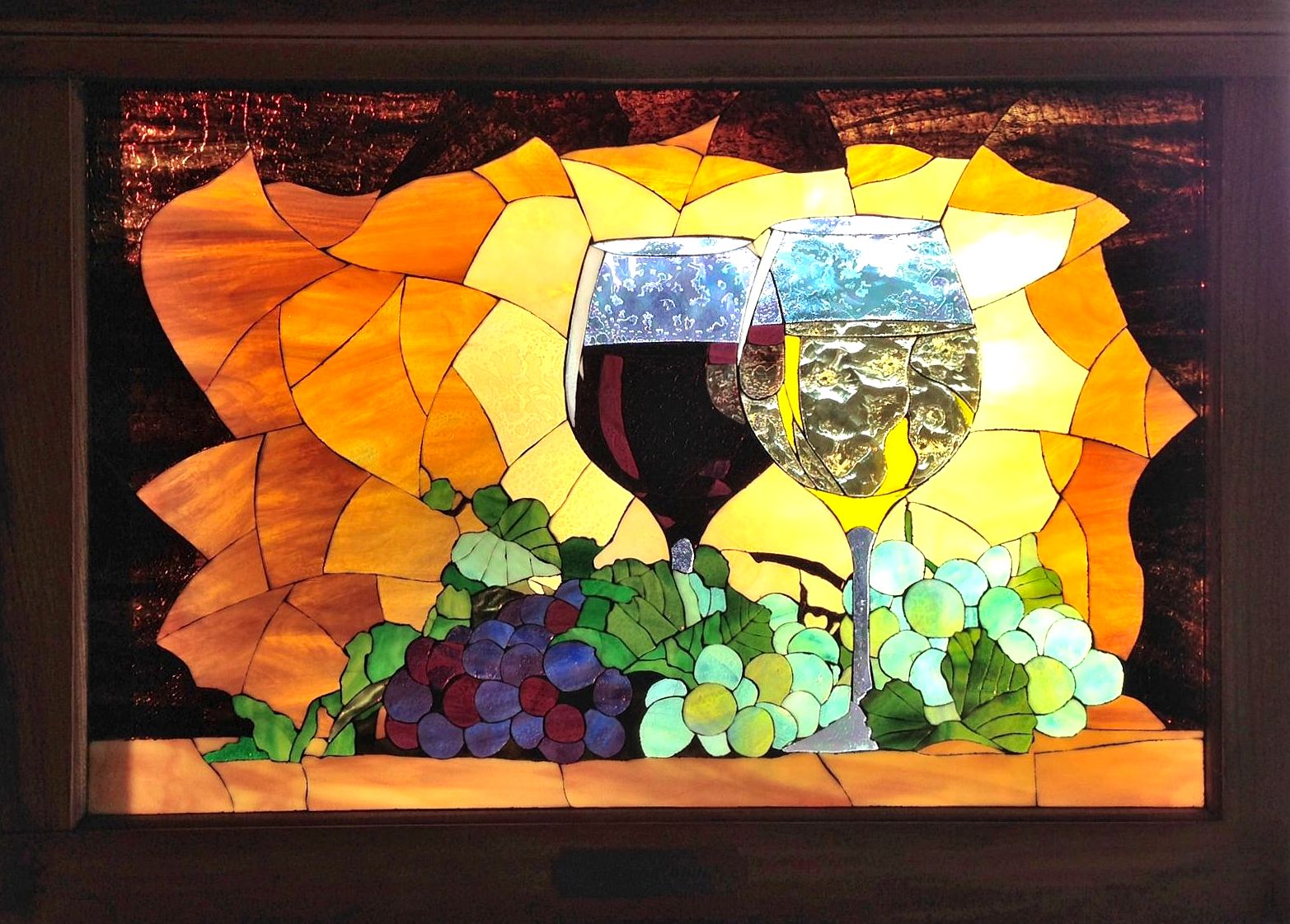
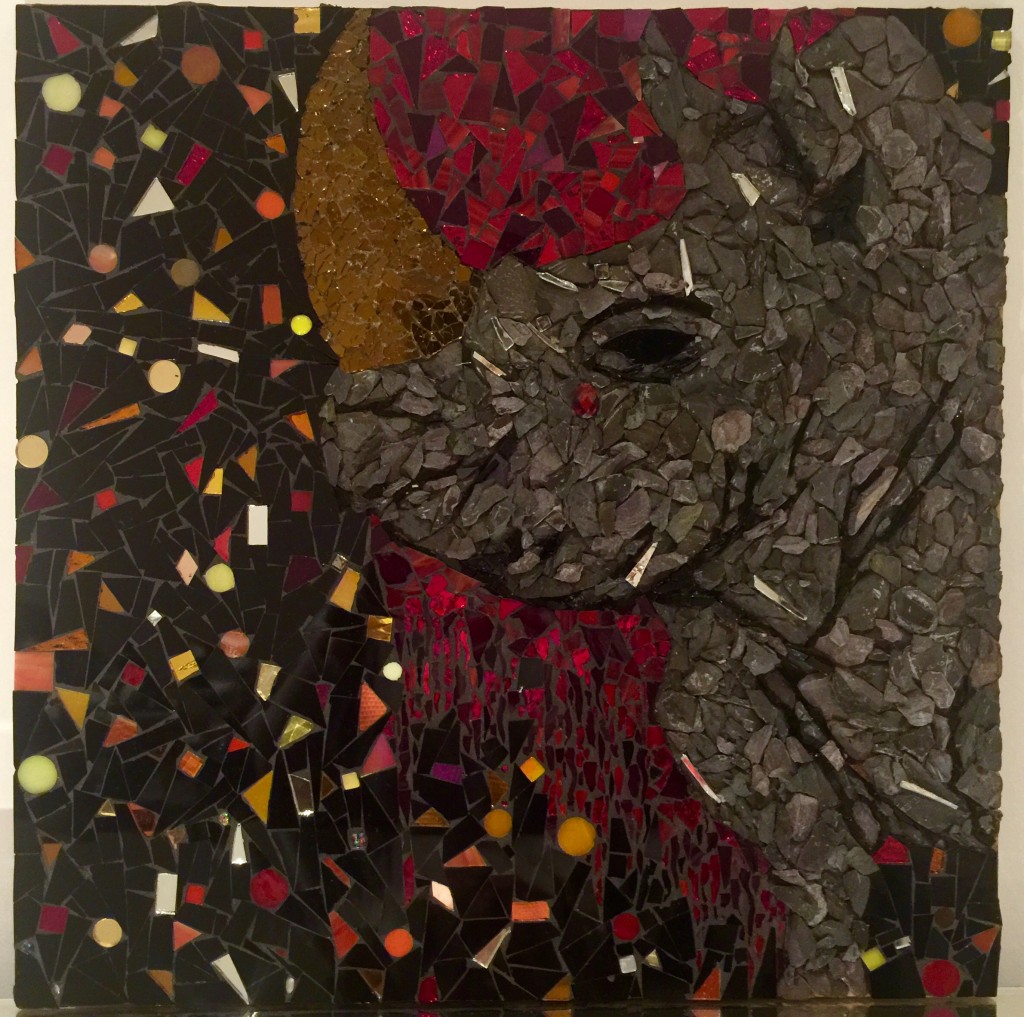 ‘My Rhino’ by Sandy Phelps, UK
‘My Rhino’ by Sandy Phelps, UK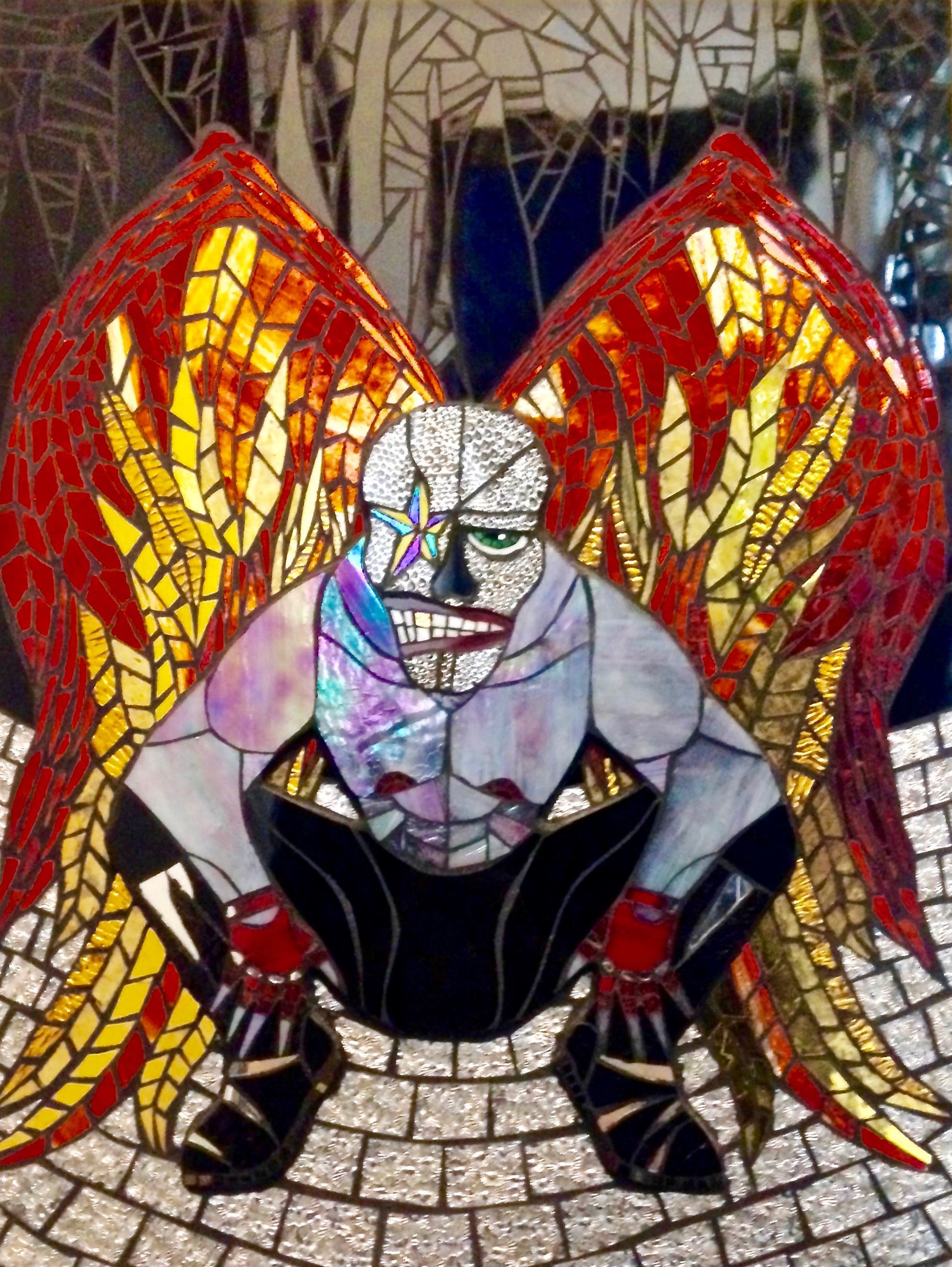
‘Kamikaze Angel’ by Chris Shoulder, UK.

‘Ebb and flow’ by Heather Stevenson, Australia www.goosehousedesigns.com.au
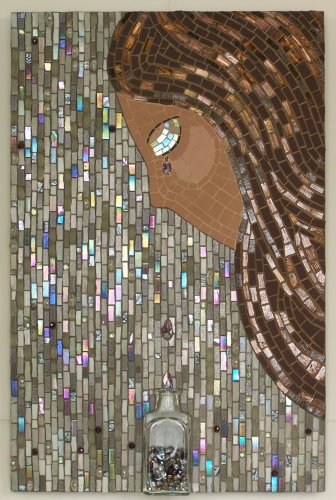
Again she cries alone
Tears fall like diamonds
Into the nothingness
Her heart lost, unknown
She cannot see
The tears of others
A shimmering, salty shroud
Connecting the broken-ones in their alone-ness
And the great Other…
Catching
every
precious
drop
Nothing is lost or forgotten.
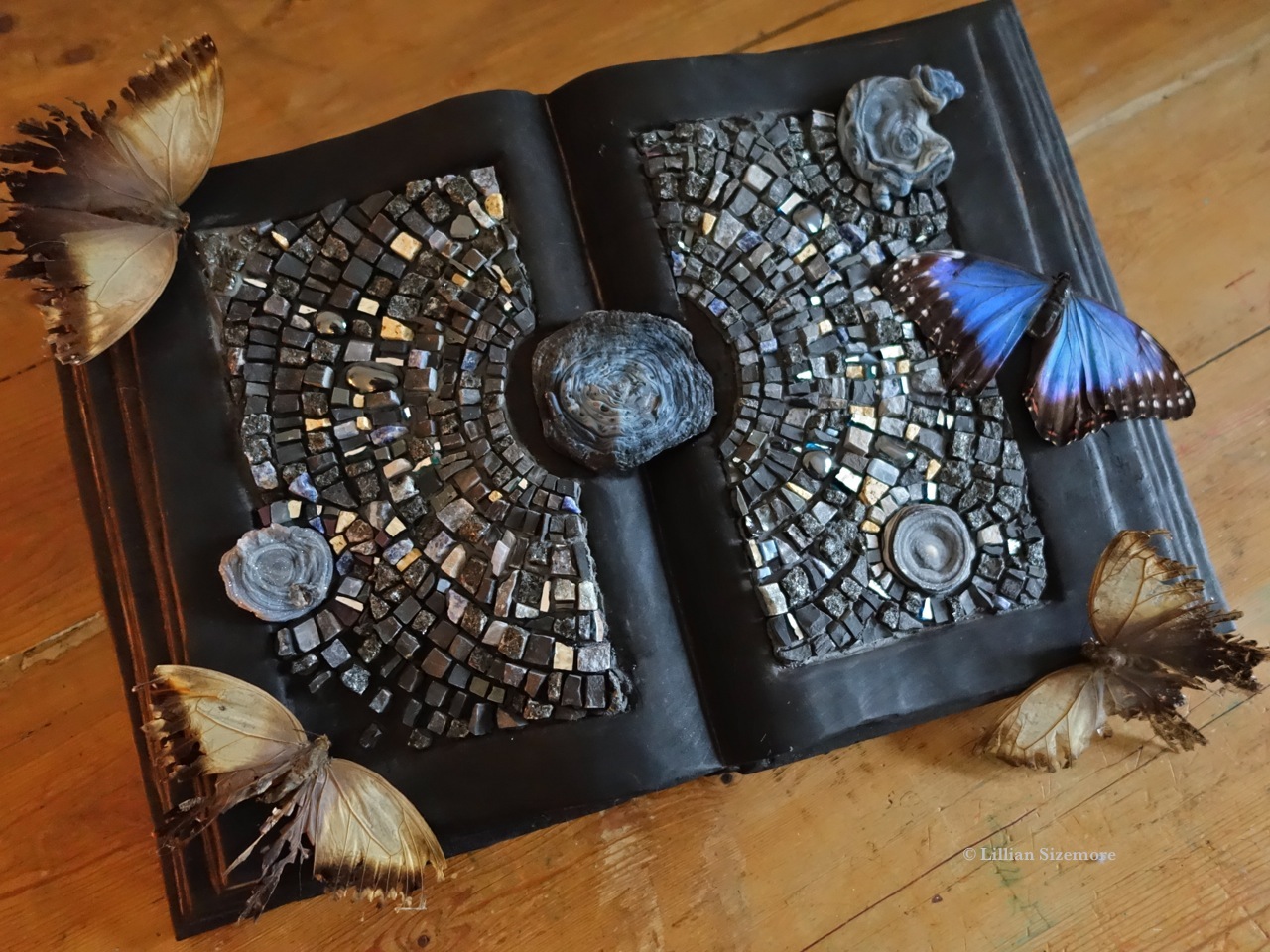
‘Opus Nigredo’ by Lillian Sizemore, UK/USA. LILLIANSIZEMORE.COM
A blackening, a burning, a decomposition.
A black blacker than black, and so into infinity.
Frozen tear drops on the page radiate toward pure crystalline light.
“…the End is where we start from…And any action
Is a step to the block, to the fire, down the sea’s throat
Or to an illegible stone: and that is where we start…”
— T.S. Eliot The Little Gidding, Stanza V. from Four Quartets, 1943
 ‘Everything is connected’ by Maddie Janes, Wales, UK. maddiejanes.simpl.com
‘Everything is connected’ by Maddie Janes, Wales, UK. maddiejanes.simpl.com
Finding a way to draw on the potential offered by a random mass of mosaic materials offers the opportunity to withdraw from the mundane. The studio door closes, the music goes on, the drawing board comes out and the process begins. An idea percolates. In this case, the connection between a love of bees, a bucket of scrap stained glass, a gold foil chocolate wrapper and a book with a broken spine (which I pulled from a skip when the library closed). So often, life fails to make any sense. Making something beautiful from discarded fragments is empowering. “Everything is connected” and making mosaic is taking control and finding a way to fit the pieces together to make something beautiful.
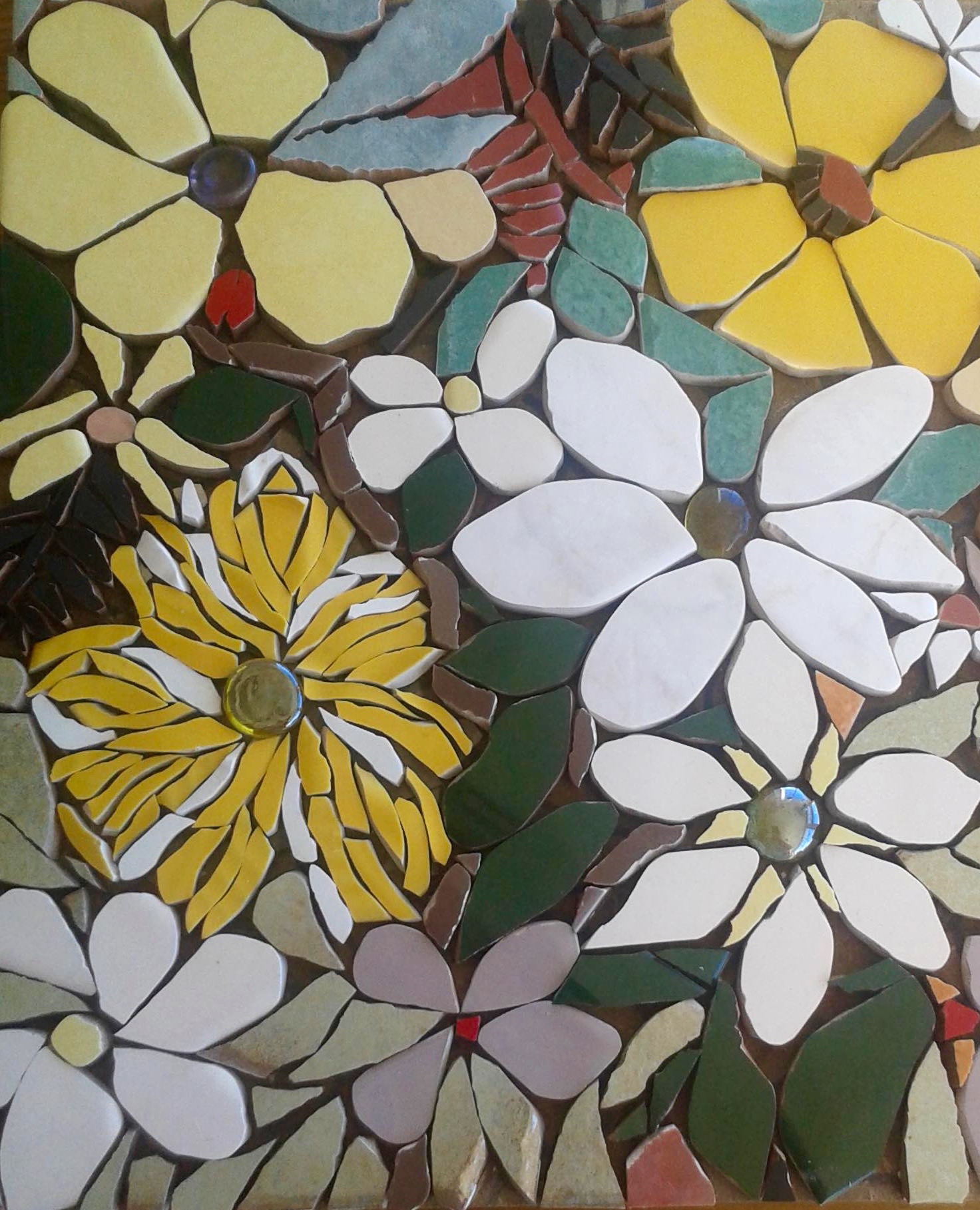
‘Looking into the hedgerow-beauty in the undergrowth’ by Claire Boyd, Ireland
I chose my mosaic of flowers as I found making it was a meditative process, working with colours and foliage in nature. The act of making and creating has been a compulsion for me. I was brought up to value investing time, effort and money for delayed gratification. I find something immensely pleasurable and powerful in the act of making something visual like mosaic as it is immediate and there is a power in being in the moment, this is my flow. The colours are healing and for me therapeutic, as I find great satisfaction in the colours and light in nature and also in the various materials I gather for mosaicking. I find a fascination too in the aspect of self-expression, the experience of expressing yourself through making art, making a statement, is such a reward.
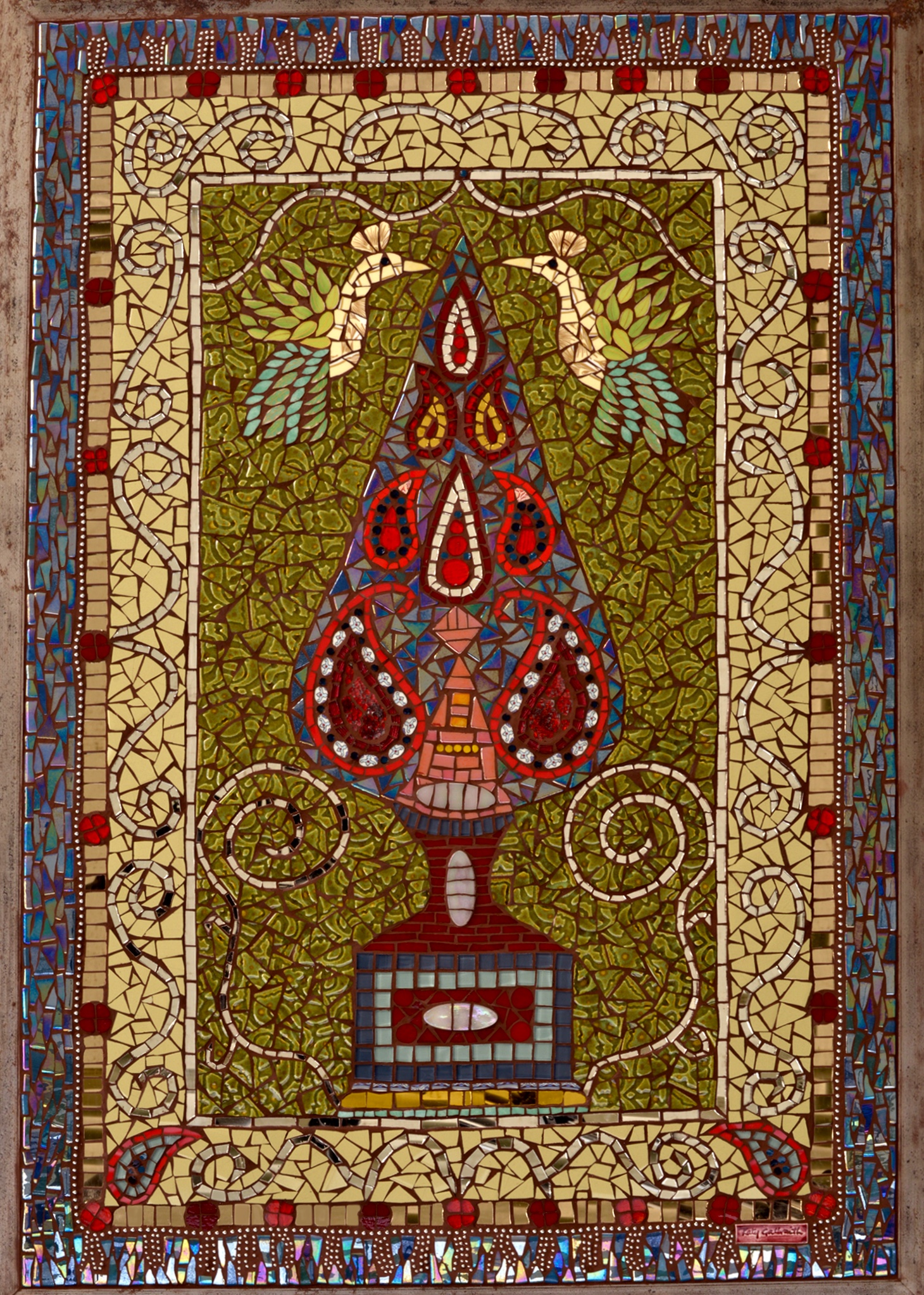 ‘Tree of Life Persian Carpet’ by Katy Galbraith, UK www.katygalbraith.co.uk
‘Tree of Life Persian Carpet’ by Katy Galbraith, UK www.katygalbraith.co.uk
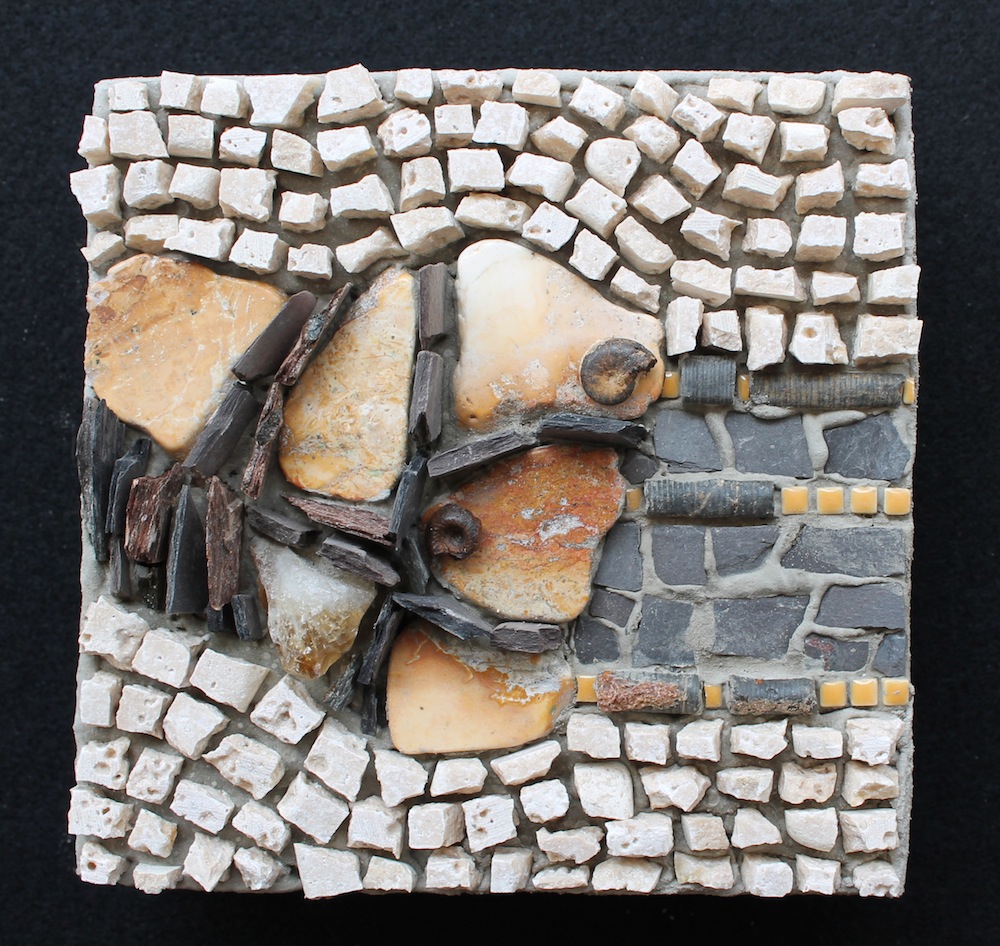
‘The Path of Least Resistance’ by Laura Lyn Stern, USA.
In life, we all have easy and not so easy times and experiences. This mosaic uses the cadence and variety of materials to express the seamlessness of how obstacles and fluidity ultimately work together.
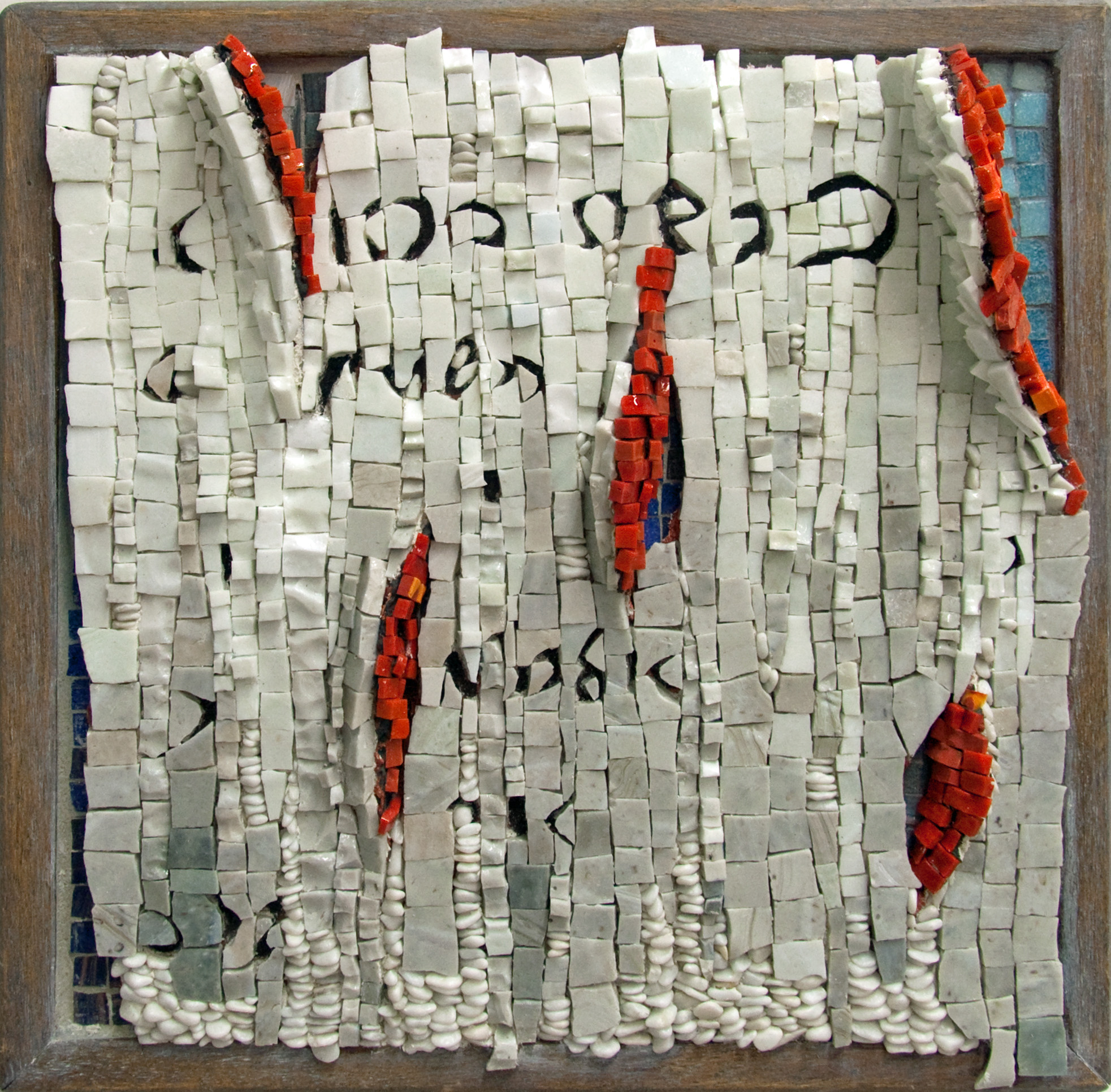
‘In the beginning’ by Marian Shapiro, Australia. http://www.dariandesign.com.
I made this a month or so after I had completed 17 back to back commissions. While positive in monetary terms this was rather less so in terms of creative satisfaction. When the commissions were over, although I had been enthusiastically looking forward to getting back to the “real” work, I found that I was stuck. As a strategy for getting out of my creative funk, I spent a lot of time looking at early work. Somehow re-using one of my earlier pieces felt far less daunting than starting from scratch. I took one of my earliest mosaics and created a new one on top of it allowing glimpses of the original to show through, thus reflecting both the original beginning of my mosaic making and the new beginning after a hiatus. The script reads “in the beginning” in Hebrew, the first three words of Genesis in the Old Testament.
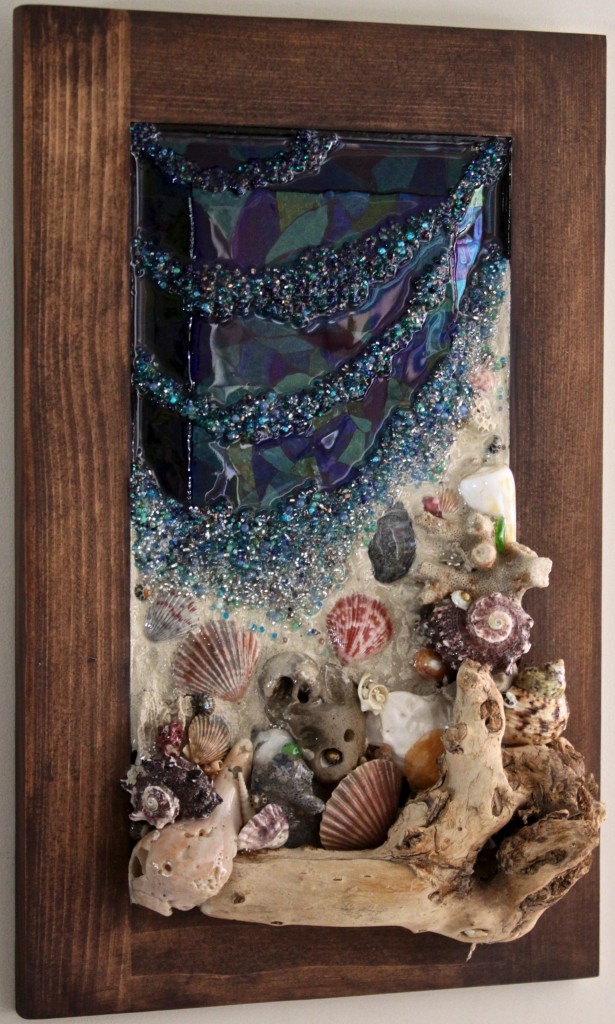
‘High Tide’ by Ashley Minkus, USA.
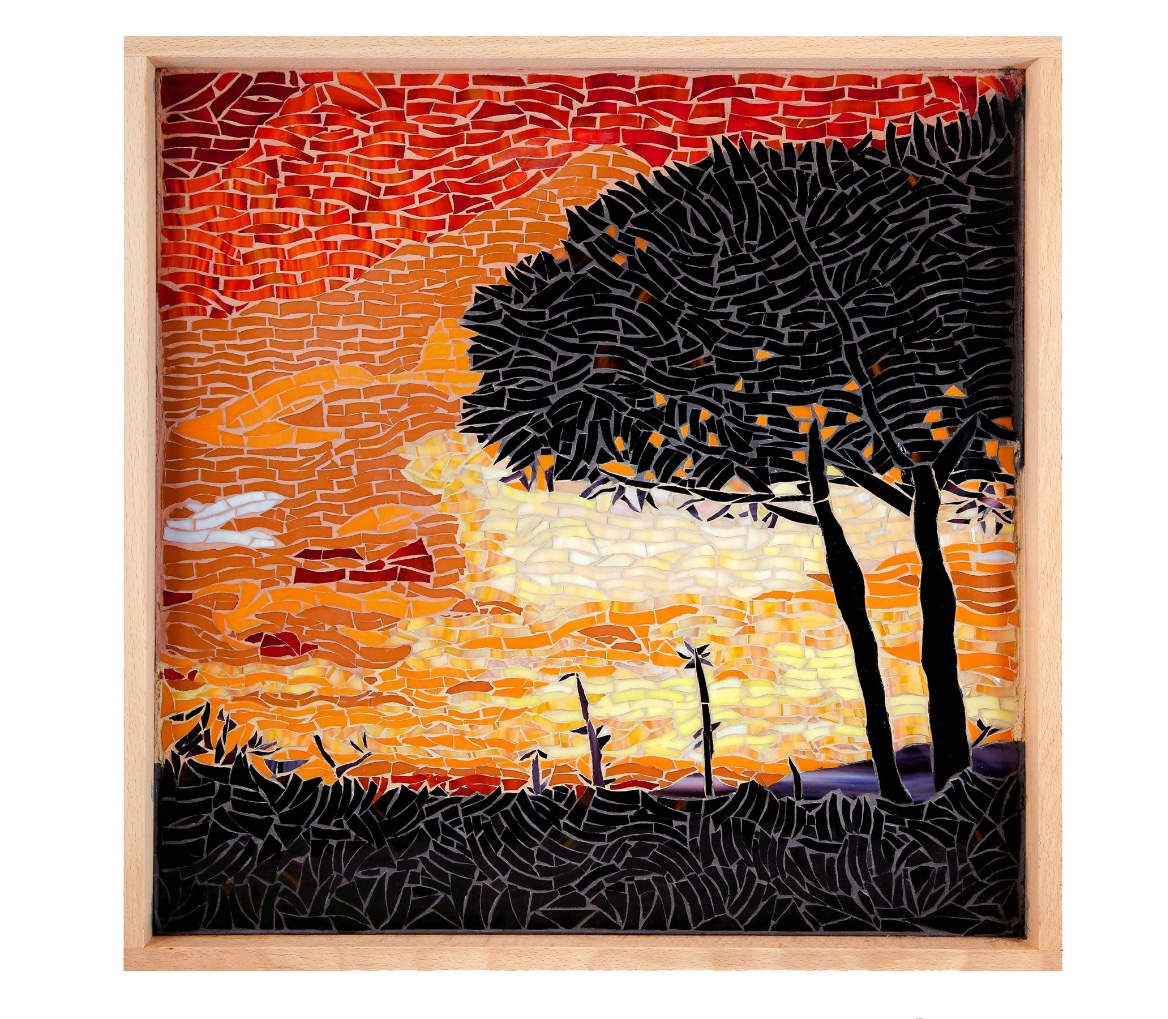
‘Italian Night’ by Mandy Duranti, Germany. http://www.mandury.de
Some years ago I met my husband. He is Italian and this mosaic shows my feelings about the romantic start of our love story. My husband gave me security, love, warmth and the power to start this new, wonderful thing in my life: mosaic art. Since I met my husband, I’m full of love for him, for Italy and for mosaic art. If we are together in Tuscany, sitting on our balcony, this tree is my view in front of the “Sleeping Dragon Hill” (Monte Argentario) and I have only one feeling: being perfectly happy, having found true love.
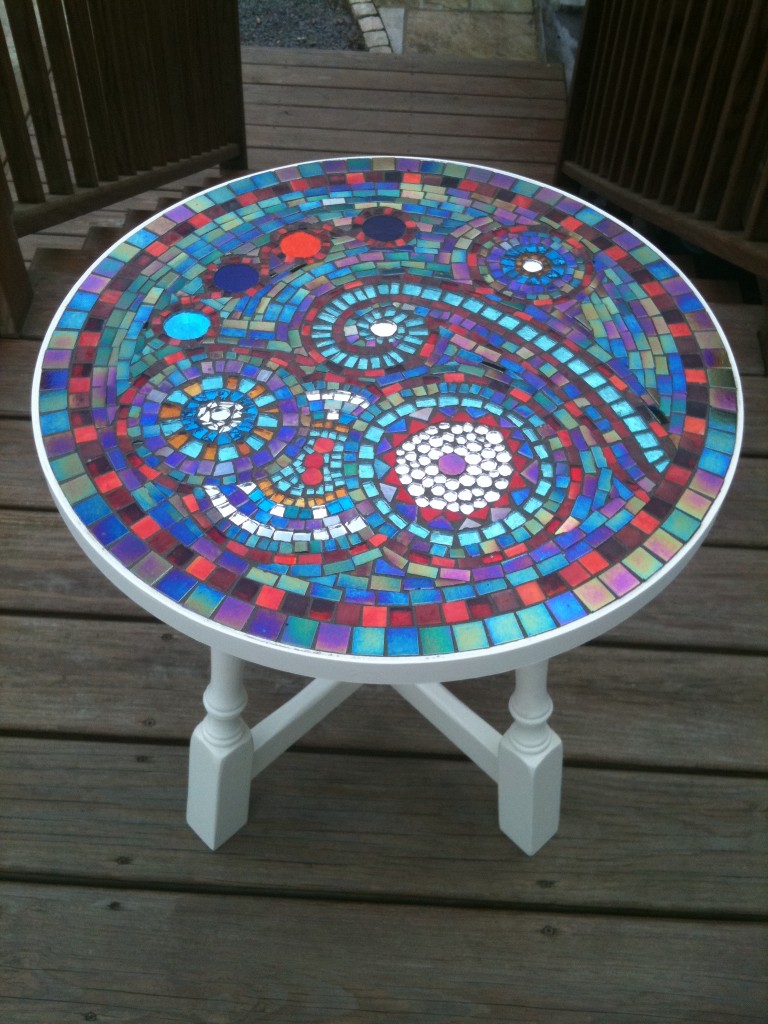
‘Family Table’ by Maedhbh Brosnan, Ireland www.smidirinimosaics.ie
At first glance you would not perceive this piece to be a “Family Table” but in every sense that is exactly what it is. It was created in a workshop that I undertook one week after my father’s death.
I didn’t have a plan when I started the design but unconsciously it literally just developed. A series of sweeping circles representing myself, my three sisters and my dad. My mother who had died 23 years previously was there also, not forgotten, but linking us all together. To one side of the large circles there are four smaller circles representing my sisters and myself as we are today. The weekend was so therapeutic for me. Helping me deal with my grief in a room full of strangers immersed in my own thoughts and bereavement. Although I was uncharacteristically silent and very weepy, this was exactly where I wanted to be, creating a piece of mosaic art which today remains in my childhood home.
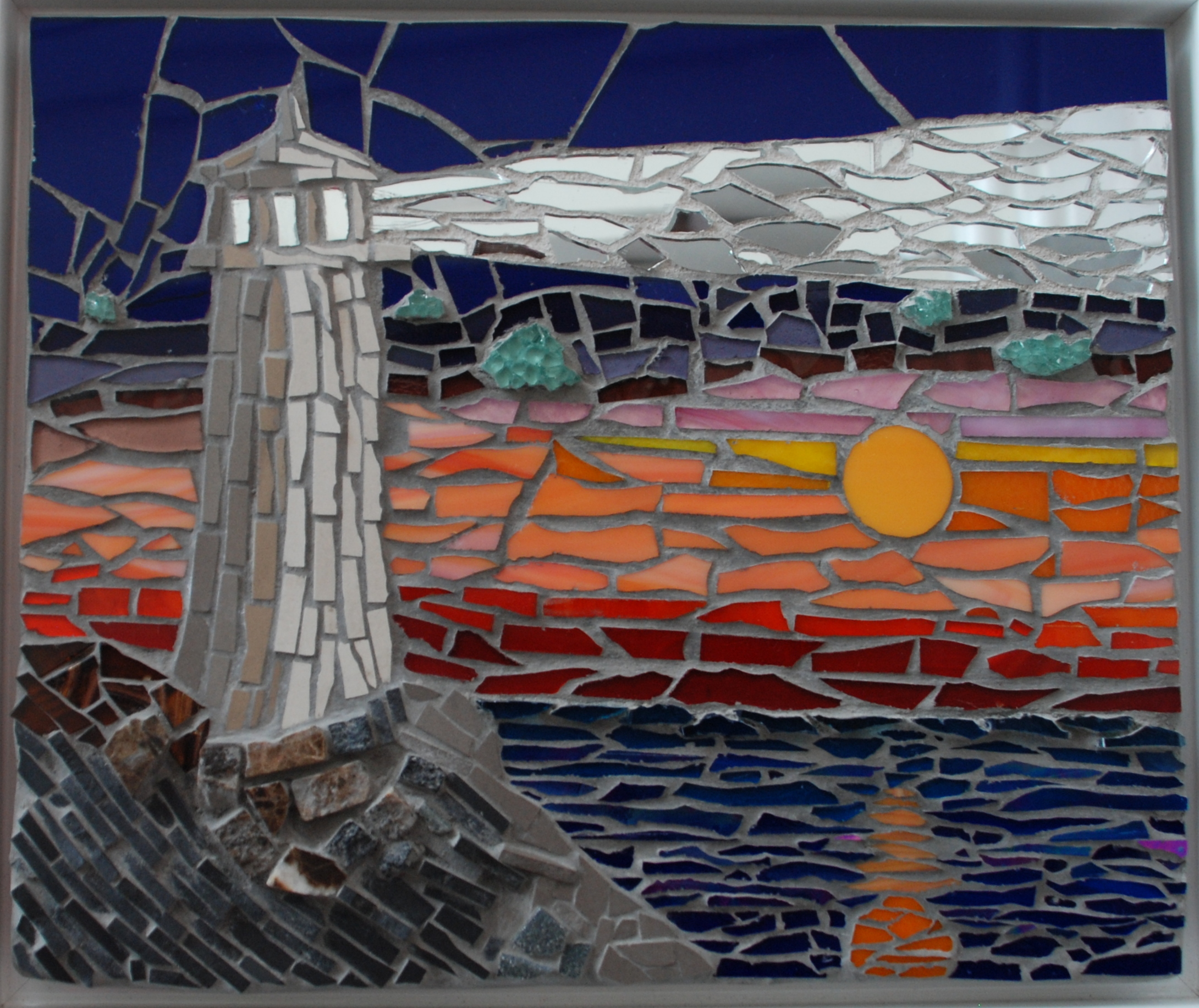 ‘Lighthouse’ by JB, UK.
‘Lighthouse’ by JB, UK.
As someone who suffers from severe anxiety, I find working with my hands highly therapeutic. Engaging in practical work can distract and soothe an agitated mind. This piece was very experimental, I allowed myself just to play with the medium and range of materials; adopting a playful approach can encourage a more carefree mind-set and I can become blissfully lost in the process. The image evolved as I worked, the cuts (like experiences in life) didn’t always turn out as expected, but these deviations were embraced and allowed to shape the composition. The fractures (like episodes of difficulty in mental health) were not hidden ashamedly from view, but rather accepted as part of the whole and have become celebrated features of the final image. My doctor has described one of my symptoms as ‘fragmentation’ and the purpose of treatment as integration; consequently this piece is metaphorical in many ways: notably the lighthouse as an enduring metaphor for hope in what sometimes feels like a dark world and the process of mosaic-ing itself entailing the integration of many fragments into a singular meaningful whole.

‘Heart’ by Kirsti, USA. www.MosaicTileMania.com
I enjoyed making this mosaic because I’ve always loved hearts, as they represent my hopeless romantic side. The iridescent glass picks bright spots, depending on how you look at it, but it all swirls around a single focal point. It’s a lot like love happens in real life!

‘Love Moscow’ by Jane Hughes, The Federation of Russia. gardenshedmosaics.com
Moving from country to country can be a daunting and unsettling prospect, and my relocation to Moscow was particularly so: no children to take to school and no job, so no obvious routes to make friends and build a life for myself. However, making mosaics has been a stabilizer in my life for many years, and here it truly came into its own; a good friend filling my mind, keeping my hands busy during my alone time, challenging me to take on new projects and keeping me balanced when I have felt wobbly. It has been a means of giving and receiving happiness. I love to work with unwanted stained glass and this piece, entitled ‘Love Moscow’, reflects my inner contentedness after two years here, and the Moscow that I have grown to love: the grand architecture; the vivid colours; the intriguing history; the firework displays and those first snowflakes of winter.
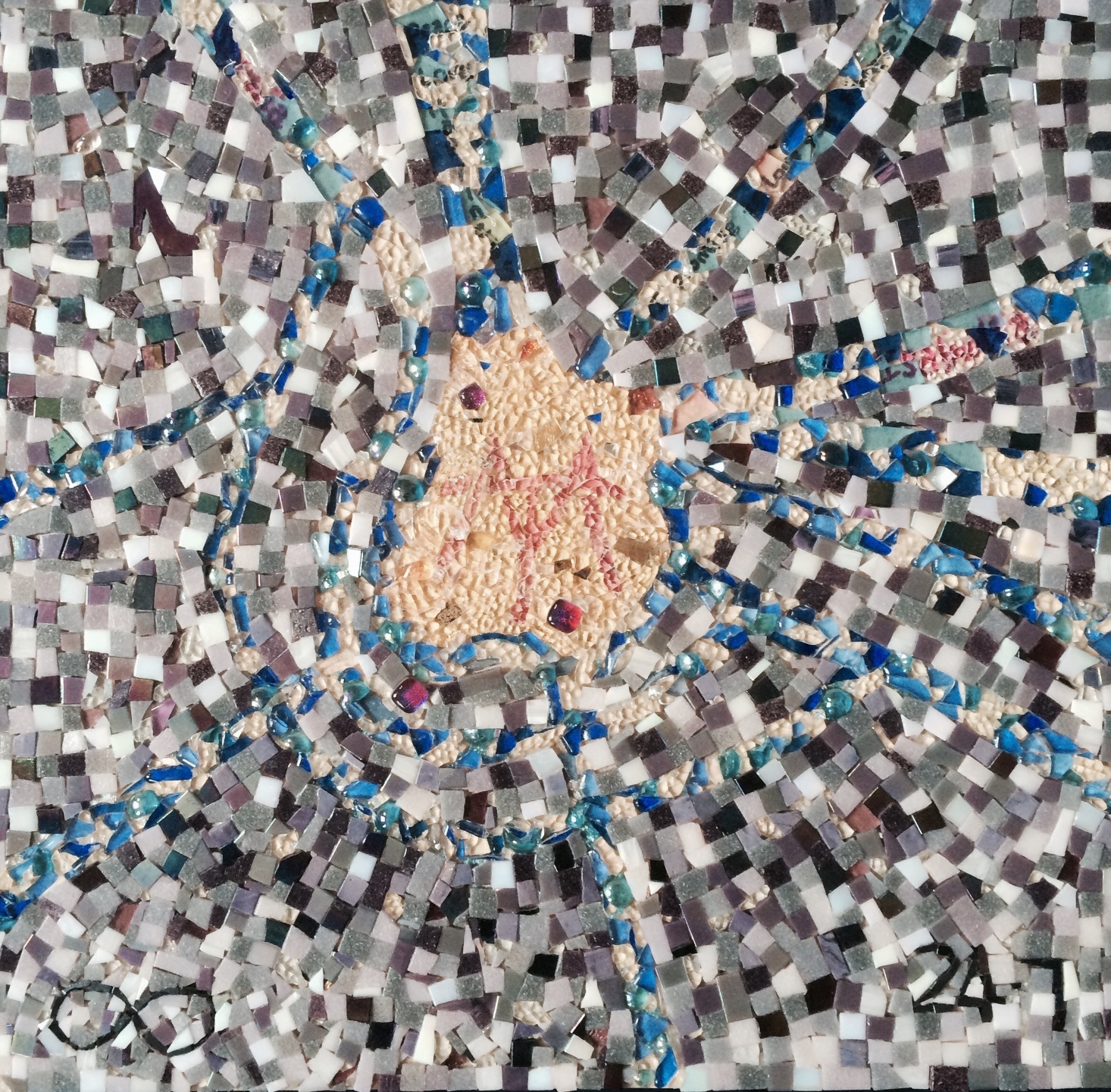
‘Twenty-four-Seven’ by Tania Ross, UK.
I chose this piece as it represents my journey, both practically through learning how to mosaic, and more importantly my personal and emotional one. It began as a present for my husband to celebrate our 10th Wedding Anniversary and grew in complexity as initial ideas (Amsterdam) germinated into something more powerful and representative of my life than I could have envisaged. I objectively explored what my marriage commitment meant to me and celebrated the things I cherish. Mosaic making awakened my inner child. It transported me to a place of peacefulness, stillness, when all that mattered in that moment was how and where to incorporate the next piece. The repetitive nature of mosaicking was incredibly therapeutic and calming. Having time to sit and just be, to think and make with colour was restorative, freeing, healing and also most importantly fed back into my life and relationships in very positive ways.
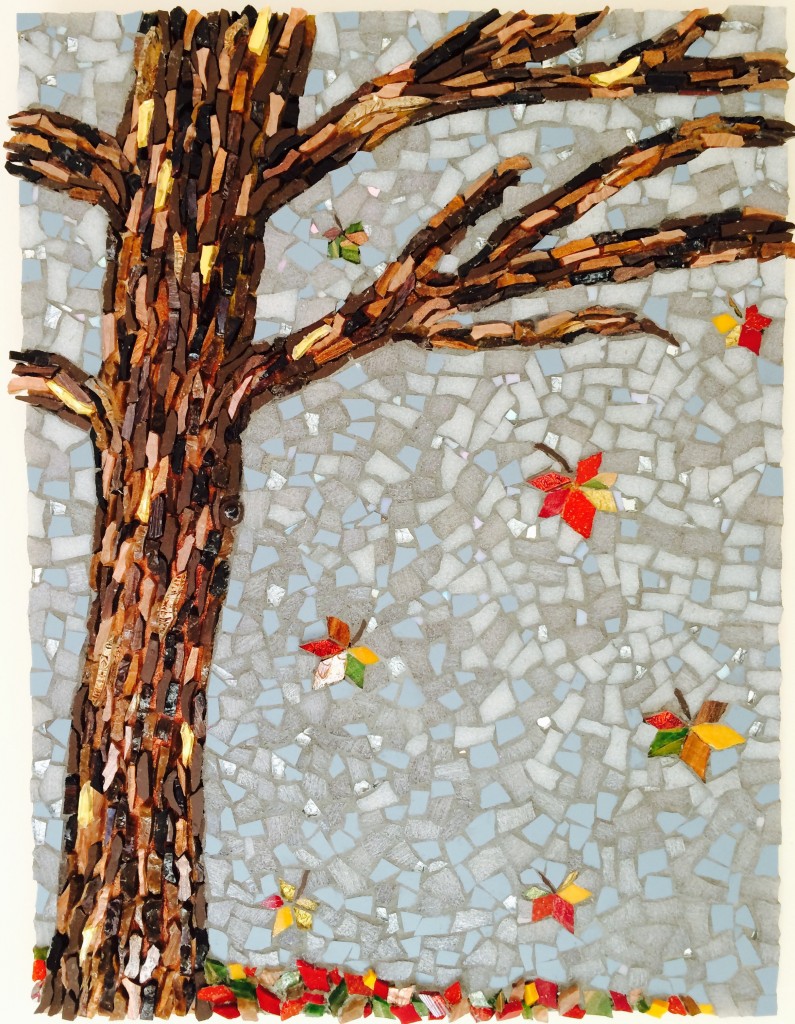
‘Transition’ by Alison Ho, UK.
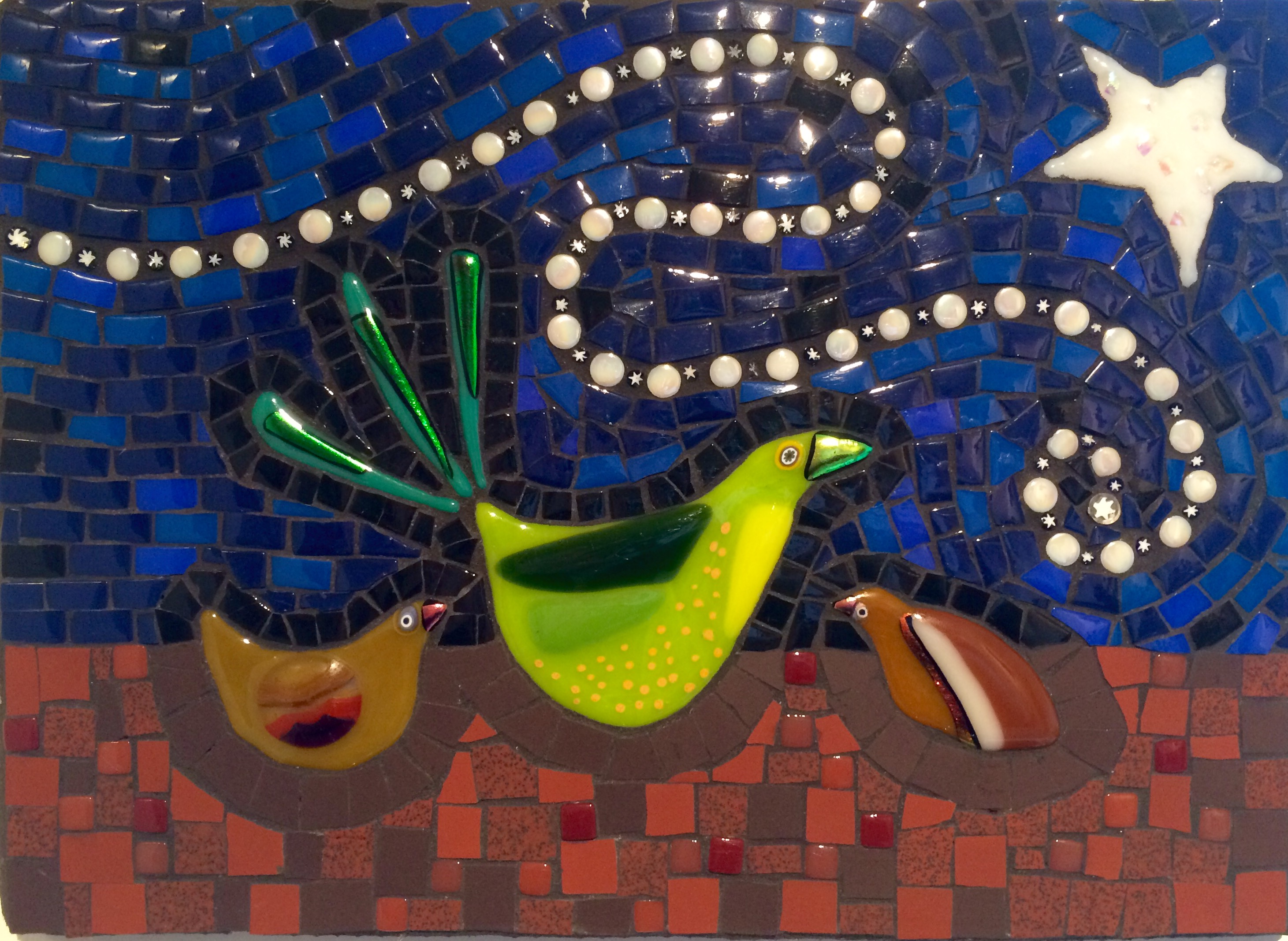
‘Night Birds’ by Denise Bagley, UK.
Night Birds’, my 7th mosaic, was commenced during a mosaic making weekend which I attended at the lovely West Dean College. I went specifically with the intention of improving my mosaic-making skills. I love the atmosphere of working alongside other mosaic artists much more than working alone. I learnt a great deal about materials and techniques. I chose to include some glass infusions into my mosaic as I really liked these. Materials often seem to influence my mosaics rather than starting with a plan! Iridescent glass is a firm favourite of mine as the colours change as the light and viewpoint varies. I simply love the process of creating mosaics and somehow I don’t really believe that I have produced mosaics that give me and others such pleasure. All I desire is more time and space to enable me to improve and hone my skills. Ten thousand hours?
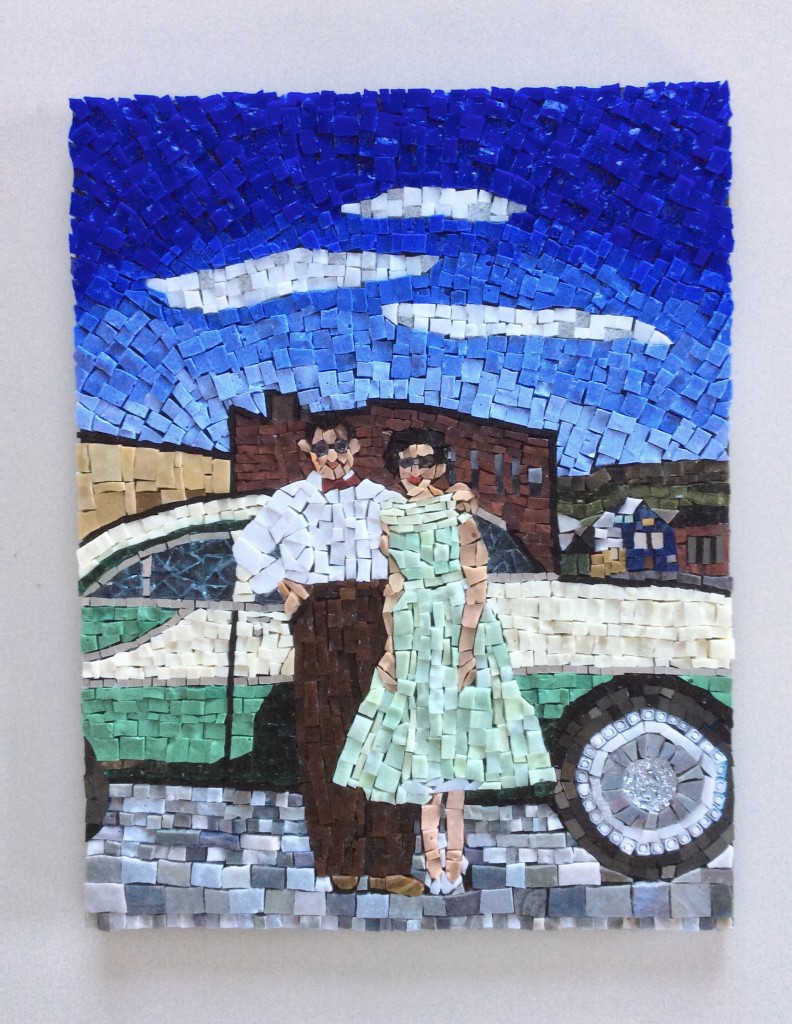
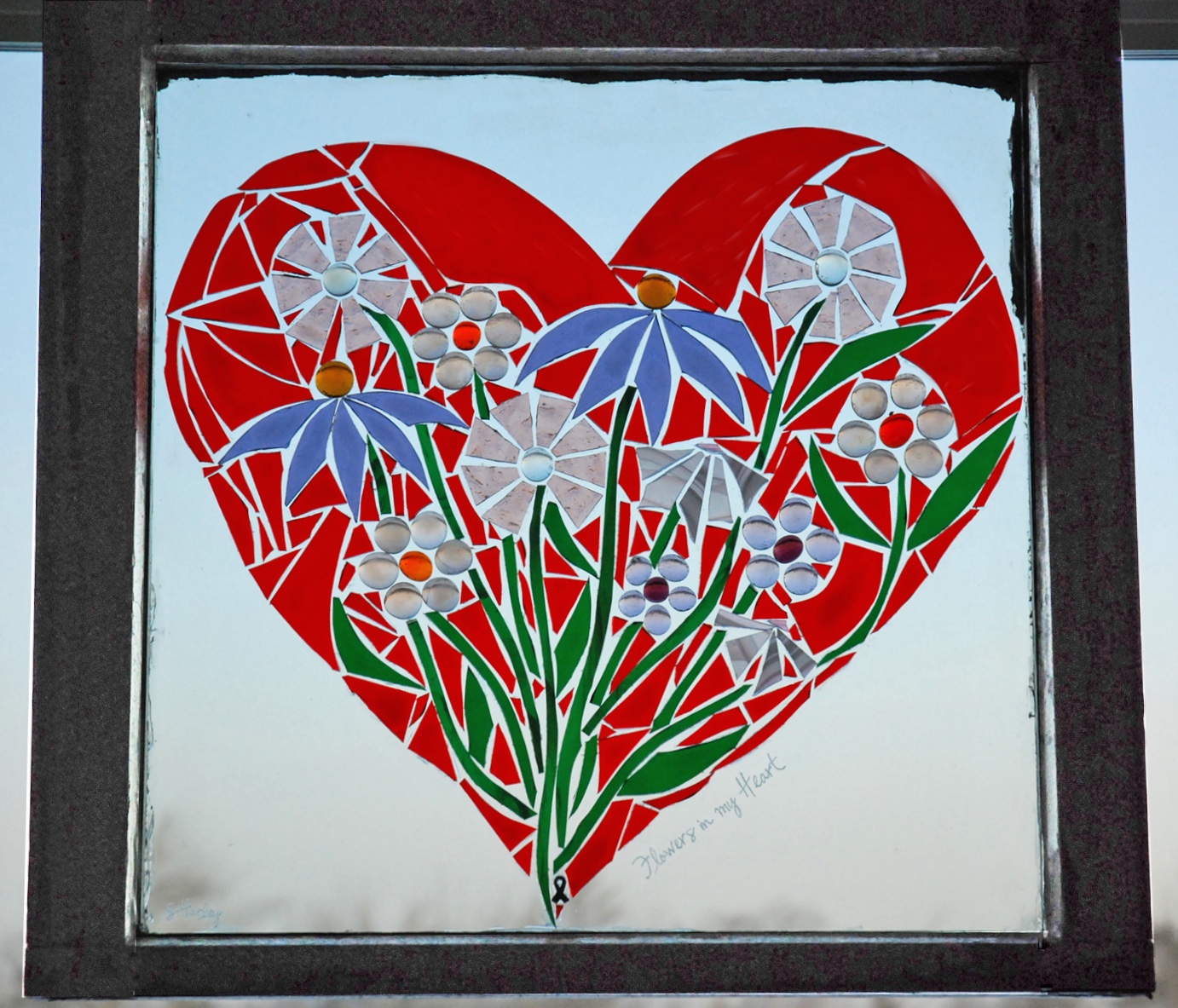
‘Flowers In My Heart‘ by Sara Harley, Canada. novascotiapostcards.blogspot.ca
 ‘Love’ by Lynda Trachtman, USA.
‘Love’ by Lynda Trachtman, USA.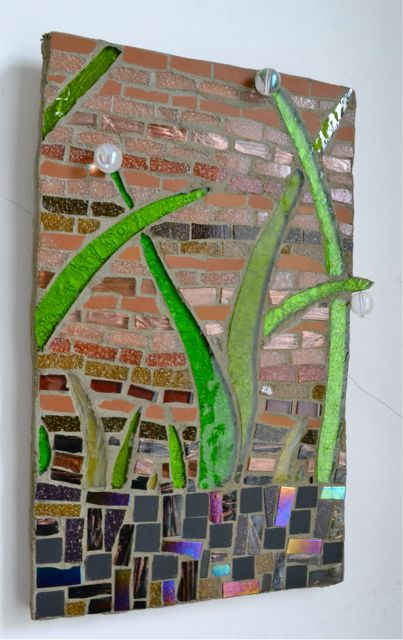 ‘Grasslights’ by Kirsten Stolz, UK.
‘Grasslights’ by Kirsten Stolz, UK. ‘Changing seasons’ by Sophia Abbas, UK.
‘Changing seasons’ by Sophia Abbas, UK.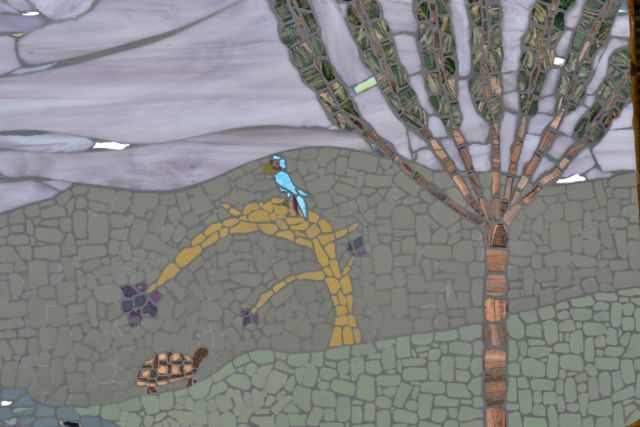 ‘Toybox’ by Anna Smith, UK.
‘Toybox’ by Anna Smith, UK.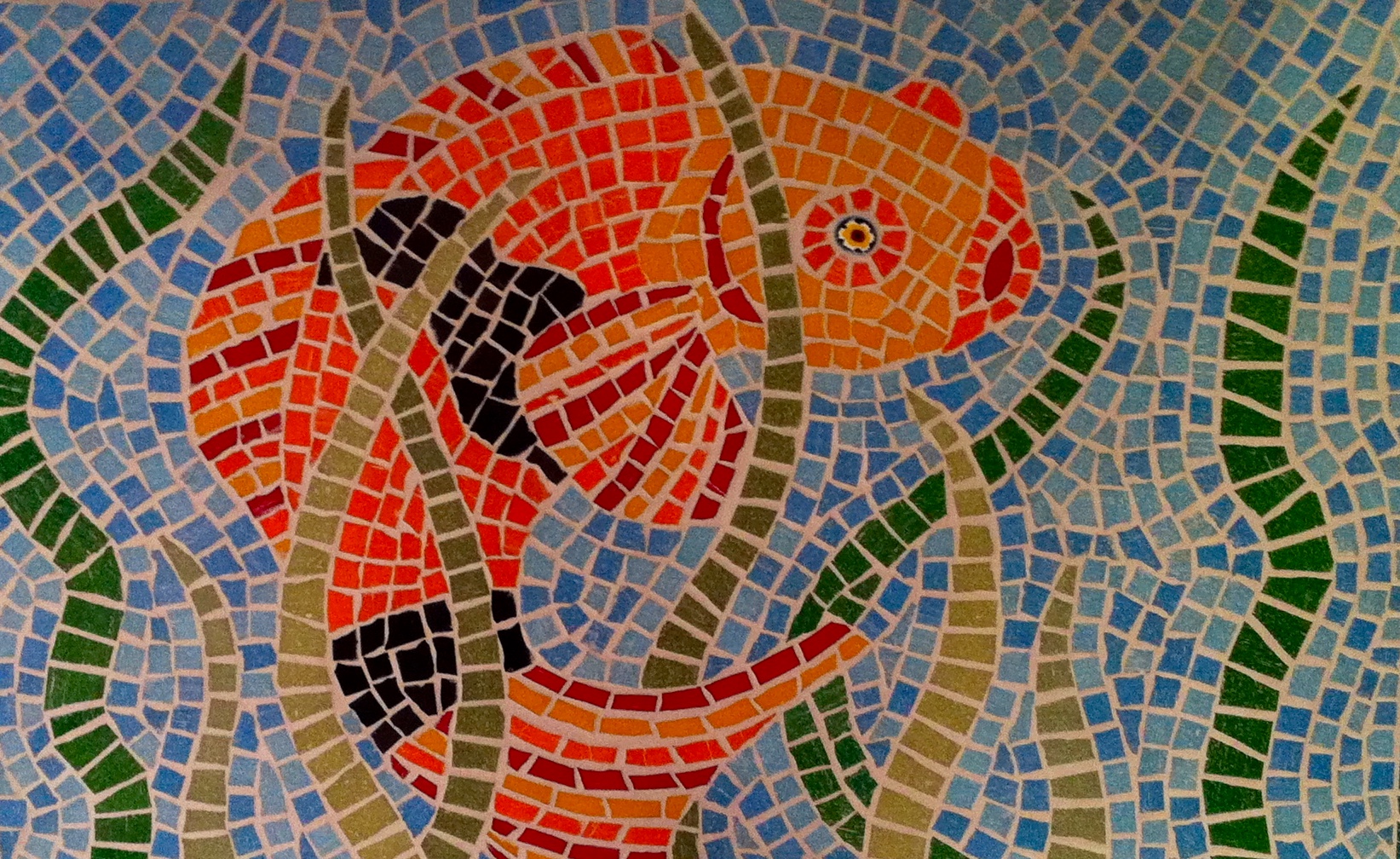 ‘Aquatic Blues’ by Claude Smith, UK.
‘Aquatic Blues’ by Claude Smith, UK.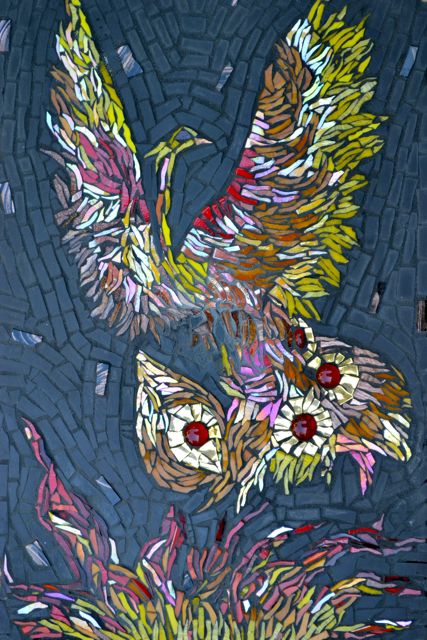 ‘Phoenix’ by Janet Hall, UK.
‘Phoenix’ by Janet Hall, UK. ‘Geometry’ by Caroline Holden, UK.I have always been drawn to pattern and decided it would be interesting to learn more about mosaic techniques through adapting a black and white design by Lynn Selwyn-Reeves. To immerse myself in the precision required to interpret this design in mosaic form was both exciting and stabilising. While I enjoy the freer forms of more fluid mosaic techniques, there is something really satisfying about completing each segment of a pattern, working very systematically to integrate parts into a whole. In a world of chaos and unpredictability, geometry, pattern and form can be very soothing.
‘Geometry’ by Caroline Holden, UK.I have always been drawn to pattern and decided it would be interesting to learn more about mosaic techniques through adapting a black and white design by Lynn Selwyn-Reeves. To immerse myself in the precision required to interpret this design in mosaic form was both exciting and stabilising. While I enjoy the freer forms of more fluid mosaic techniques, there is something really satisfying about completing each segment of a pattern, working very systematically to integrate parts into a whole. In a world of chaos and unpredictability, geometry, pattern and form can be very soothing.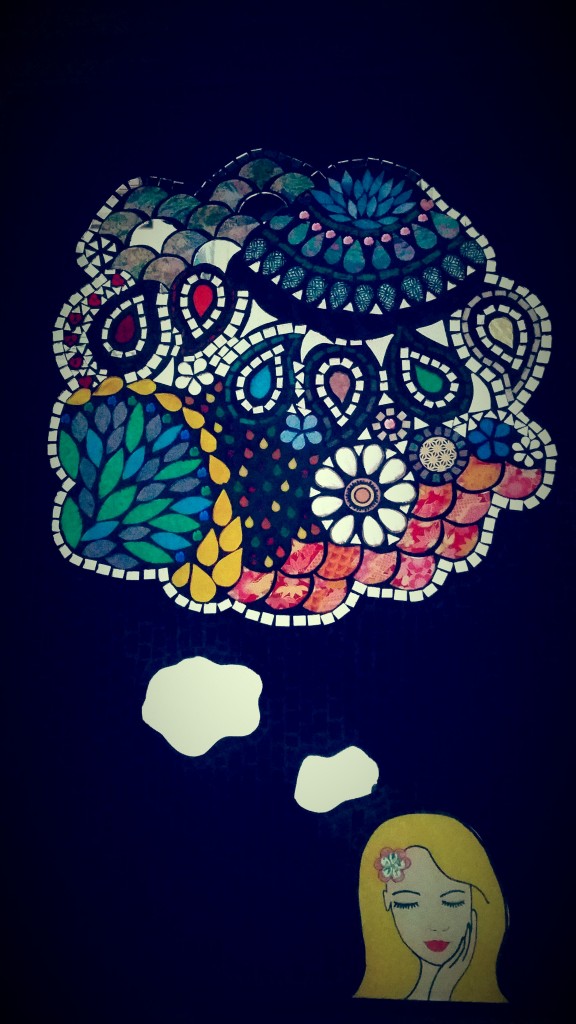
‘The Creative Mind’ by Catherine Conaty, Australia www.facebook.com/cairomadethat
I originally created this piece for an exhibition which had the theme ‘Illuminate’. This is my mind when my mosaic mojo is flowing, when all the time I am thinking about colours and patterns, in other words, lit up with possibilities. Its a little bit scrambled, yet somehow comes together cohesively. I see the world with mosaic eyes…..I cant help it!
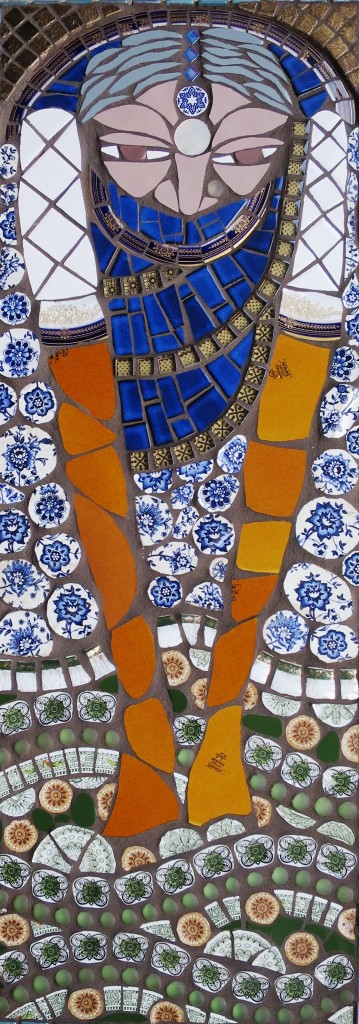
‘Nanni-Ma’ by Caroline Jariwala, UK.
http://www.carolinejariwala.co.uk
My creative process has shifted from painting into mosaic. I see myself ‘painting in mosaic’. Mosaic has broadened my creative approach, by using a given pattern it helps free up new possibilities and wider choices for invention. There is something potent when mosaic-making with broken, chipped, discarded, rejected and second-hand crockery. Using the unwanted and making it desirable; transforming ‘ugly’ into a thing of ‘beauty’. The everyday, thrown away, is picked up and cherished… sometimes by the very people that rejected the item in the first place! My mosaics celebrate the everyday woman. I honour a woman like Nanni-Ma, who worked so hard during her long life her hands have disappeared. Mosaic can play a vital role in our well-being. We can use it to be reflective within our own circumstances, by literally piecing together a new meaning, or by helping us see what is already there.
***
If you would like to submit a photo for consideration in the exhibition and forthcoming book (ongoing) please follow these instructions.
References
Csikszentmihalyi, Mihaly (1990) Flow: The Psychology of Optimal Experience
Jamison, K.R (2011 ) Great wits and madness: more near allied?”
Rappaport, L (2014) Mindfulness & the arts therapies
Severini, G (1952) from “Mosaic and Mural Art in Antiquity and in Modern Times”
Sizemore L (2012), from presentation to the British Association of Modern Mosaic Annual Mosaic Forum, https://sfmosaic.wordpress.com/tag/gino-severini/